Cancer
Diaries
Part Seven:
Medical Civil War
Written by
Rick Archer
September 2013
I can prove anything by statistics except the truth.
- George
Canning
The progress
of science is strewn, like an ancient desert trail, with the
bleached skeletons of discarded theories which once seemed to
possess eternal life - Arthur
Koestler
|
|
 |
|
|
In the previous chapter, Dr. Oz referred
to a Medical Civil War.
"Modern medicine is a
“Civil War”
waged between conventional physicians and those who are open to
alternative cures for
maladies ranging from anxiety to cancer..."
One needs to look no
further than the picture on the right.
That picture, my
friends, is the face of the Medical Civil War. That is Doctor
versus Doctor, plain and simple.
And it is a war.
It is a war of competing medical technologies. Except we
aren't talking Beta versus VHS or the Electric Car versus the Gas
Guzzler here. We are talking about human lives. The FDA
guards the Watchtower and Burzynski is trying to muscle his way in.
Someone has to stop him. The situation is so desperate, the
FDA is willing to spend...
60 MILLION DOLLARS
|
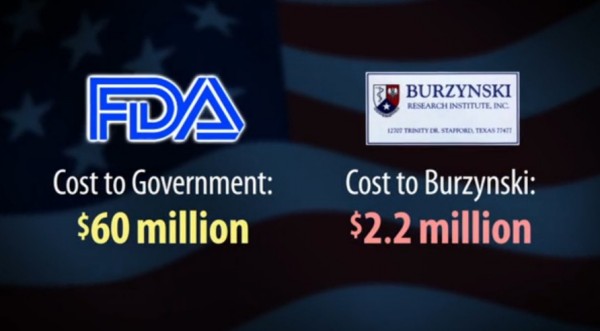 |
I previously wrote about
Burzynski' struggles in Chapter Three.
Out of curiosity, do you
even remember what Burzynski's $60 Million 1997 Grand Jury Trial was about?
I bet you don't remember.
Was it started by
complaints from disgruntled patients or survivors of the dead who
were angry at Burzynski? No.
Was it started by
evidence that Burzynski's treatment was physically harmful to the
patients? No.
Was it started by
evidence that Burzynski's treatment was ineffective? No.
In fact, the prosecution even admitted there was value to the
treatment.
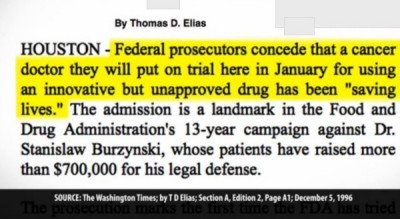
The U.S. Government
spent $60 million dollars trying to convict Burzynski of allowing
his antineoplaston treatment to cross state lines. Have you ever
heard of anything more ridiculous?
Burzynski won because he
was always careful not to ship it out of state. This forced Burzynski's
patients to come to Houston from out of state. These patients
then took the treatment home
with them of their own volition, thereby crossing the State Line.
One has to ask what difference
would it make if Burzynski did ship it? What kind of stupid
game is this? For crying out loud, the man
is trying to save people's lives.
So what is the real
reason our Government would spend a King's Fortune of your tax
dollars and my tax dollars to prosecute a man for any reason as pathetic
as this?
The answer is simple, my
friends. Cancer is big business.
Cancer is so important,
people will stop at nothing to keep the present system intact.
|

The Crime: Burzynski was accused of illegally
transporting
his life-saving treatment across State Lines.
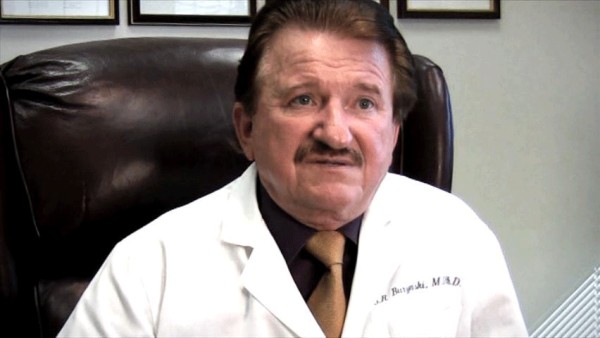
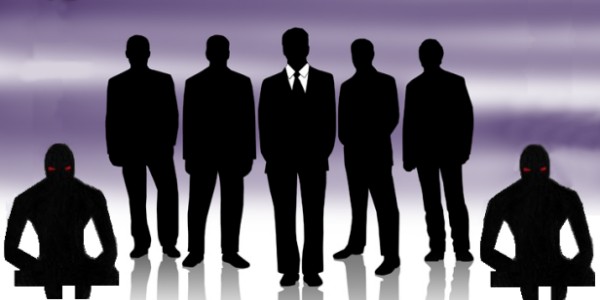
|
Cancer isn't just big,
it's real big.
Cancer has become "too big to fail".
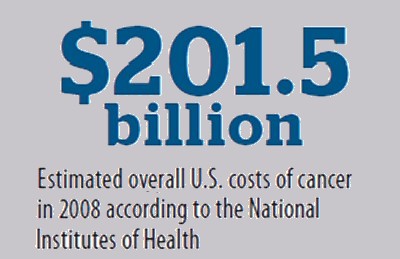
To these people,
spending $60 MILLION to protect a $200 BILLION DOLLAR INDUSTRY makes
perfect economic sense.
|
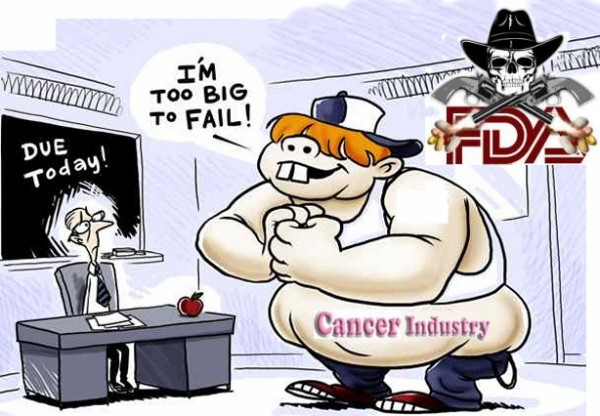 |
|
Why Won't the
Medical Community Back Burzynski's
Work?
|
As
one can gather, I personally think Burzynski is on to
something. His work shows great promise.
However I don't think he is quite there yet.
I
firmly believe if the constant harassment would
be lifted, Burzynski would make better progress.
It
would also be correct if Burzynski's work could
be evaluated fairly.
In
the Chapter Three article, we saw a cancer
researcher named Li-Chuan Chen come forward to
lend credence to the allegations that previous
testing of Burzynski's work by the NIH (National
Institute of Health) in 1995 had been deliberately
sabotaged.
(click
here to review this claim in Chapter Three)
|
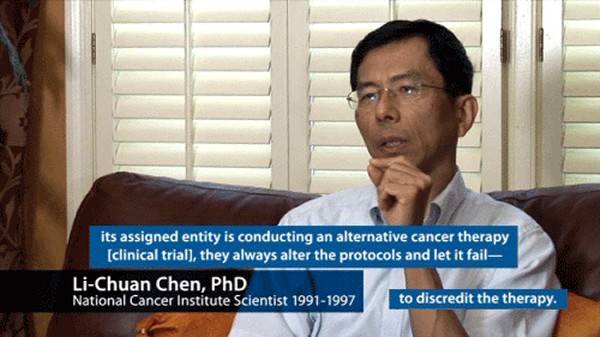 |
There were also serious allegations of patent
infringement.
Dr.
Chen made it clear that the government's move to
patent Burzynski's treatment behind his back was
clearly an illegal attempt to steal his life's
work.
(click
here to review this claim in Chapter
Three)
Meanwhile, my critics have begun to lose respect
for me thanks to my wacko conspiracy theories.
|
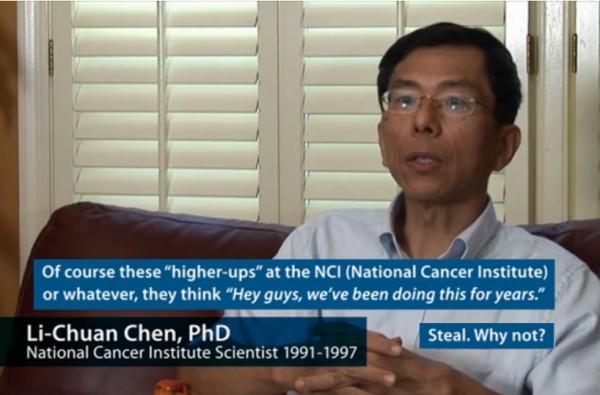 |
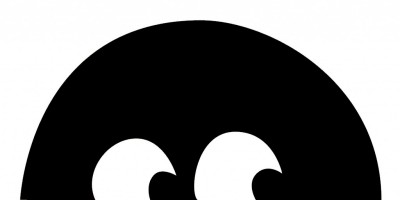 |
"With
all due respect,
Rick, my faith in you
having a completely open mind is ebbing.
The conspiracy
angle you speak of is
ludicrous considering the number of people and
governments that would have to be involved.
Once you've made up your mind with the
conspiracy angle, presenting the other side with
reasonable explanations runs into a brick wall."
$60
Million Dollar Witch Hunt. Sabotaged test
trials. Blatant patent infringement.
How
long does the list have to grow before people
start to "get it"?
|
Yes, it is
true. My mind is made up on the Conspiracy Angle.
Someone is clearly out to get Burzynski.
My money is
on the pharmaceutical industry who stands to lose
billions if Burzynski's treatment puts them out of
business. The entity that stands to lose the most
is always the most likely suspect.
And I
understand that hospitals stand to lose money. Those
hospitals most cost a fortune to build and to maintain.
Unfortunately for them, Burzynski's patients actually
take their medicine home with them... they walk around
with a medical pouch that gently seeps ANP serum into
their bloodstream on a daily basis. Hospitals are
certainly vulnerable if this tactic becomes wide-spread.
However, there
is one
question I have not been able to answer to my own
satisfaction is Burzynski's obvious lack of support in
the Medical Community. "Why doesn't the Medical
Community support Burzynski?"
In other
words, why don't doctors and researchers investigate
Burzynski more closely and come to the same conclusions
I have made based on the documentaries?
This
question is very troubling to
me. Burzynski's critics are loud and vociferous.
They claim that he is a fraud and a charlatan at every
turn.
Wikipedia
shows complete contempt for Burzynski. In fact, I
have noticed that sometime within the past three months
that I have been writing my Cancer Diaries,
Wikipedia's language has changed to become even more
dismissive. (Original
Wikipedia Profile)
The Burzynski Clinic is a clinic in Texas, United
States founded in 1976 and offering unproven cancer
treatment. The clinic is best known for the
controversy surrounding its "antineoplaston
therapy", a chemotherapy using compounds it calls
antineoplastons, devised by the clinic's founder
Stanislaw Burzynski in the 1970s.
The clinic has been the focus of much criticism due
to the way its unproven antineoplaston therapy is
promoted, the costs for cancer sufferers
participating in "trials" of antineoplastons,
significant problems with the way these trials are
run, legal cases brought as a result of the sale of
the therapy without board approval, and for other
causes.
Burzynski immigrated to the United States in 1970
working at Baylor College until 1977, when he
established the Burzynski Research Laboratory, where
he administered antineoplaston therapy, initially to
21 patients then more widely as "experimental"
treatment, immediately opening himself up to
"charges of unethical conduct and to the suspicion
he had become a merchant of false hope".
Having effectively exiled himself from mainstream
medicine, Burzynski pursued a course of promoting
his offerings using publicity, and "aggressively
[seeking] out ... terminally ill cancer patients",
leading to several instances of media controversy.
In 2013, Burzynski was awarded the James Randi
Educational Foundation's Pigasus Award, which is
bestowed each April Fool's Day on frauds.
That strange comment about the "Pigasus Award" is
recent. Considering Wikipedia claims to be
"scholarly", that undignified statement is so uncalled
for that it actually helps make my point that Burzynski has enemies within the medical
community. That is obvious.
Now the
question is 'why'. Why is Burzynski detested by so
many?
The first and second Burzynski
documentaries made it clear (at least to me) that
Burzynski is well on his way to curing cancer. If
so, then why does he have so much opposition not just
from the Conspiracy manipulators at the top, but the
vast Medical Community as well?
Why would these
medical people refuse to back a man who appears to be on
the road to curing cancer? Why would they let
Burzynski hang in the air while the FDA and the NIH
continue to crucify this guy?
There are
two obvious possibilities.
First,
Burzynski is a threat to put people out of business.
He definitely on to something and the
entrenched interests are pulling a Morris Fishbein
attempt to suppress his technology long enough that they
can steal it, duplicate it, or catch up to him.
Given the desperation of methods such as the 60 Million
Dollar Trial, that could very well be the answer.
However, there is also a much less pleasant
possibility. Maybe Burzynski's cure is
nowhere near as effective as he claims it to be.
Maybe he really is a charlatan. Perhaps
people in the medical field wish to stop Burzynski
because they don't trust him or his work. They think he is either a fraud or he is
misguided.
Of
course it is this
second possibility that troubles me. For me to be
right, these people have to be wrong. Only one
problem - they know more about medicine than I do.
Considering my personal lack of medical
knowledge, I am at a serious disadvantage here. That gives me pause for thought. Am I backing the
wrong horse?
|
 |
| |
The Ultimate Question: Who is Right and who is Wrong?
One would
assume that the Medical Community with all its vast
knowledge knows exactly what it is doing. However,
in my previous article on "Medical
Mysteries", I made it perfectly clear that
medicine gets it wrong from time to time.
In
particular, history has shown doctors have a bad habit
of "getting it wrong" whenever someone's pocketbook is
affected.
- In case
one has forgotten, something as important as a cure
for Smallpox was postponed for four years in part by
the
variolators.
- In case
one has forgotten, there was an anecdote in the
Morris Fishbein chapter how Royal Rife's cure for
chronic colitis
was suppressed because the doctors were angry that their
cash-cow
patients were being cured.
- In case
one has forgotten,
Barry Marshall,
the man who cured ulcers, was convinced his work was
ignored for fourteen years because too many people
were making too much money to bother paying
attention to him.
So yes, I
think we can all suspect that the closed-minded attitude
prevalent in the Medical Community towards Burzynski
could have an economic motive behind it. There is
currently a heavy propaganda campaign being waged
against Burzynski on the Internet. The Wikipedia
listing cited above is an obvious example. While the
doctors argue that Burzynski's treatment is false,
dangerous, and ineffective, anybody with a brain can see
these doctors' arguments could just as easily be
motivated by fear of the competition.
Still, in
the end, if we can put the propaganda wars aside,
Burzynski still has to meet the ultimate medical
challenge.
Can
Burzynski prove his treatment works?
|
| |
|
|
The Great Debate -
Does Burzynski's Treatment Work? |
FORWARD
Although it took
some prodding, I finally got a Hopkins-trained cancer
researcher to explain why Mainstream Medicine is so totally
opposed to Burzynski.
I think for the
following debate to make any sense, the reader needs to
understand that Dr. Research,
as I will refer to him, was very reluctant to share this
information.
I do not know
why he resisted participating, but I will say he was
deeply concerned that I would publish his answers. For the
record, he repeatedly asked me not to.
I am what is
known as a "whistleblower". I write these articles
because I believe the truth about
Burzynski is being suppressed. However, in a sense,
Dr. Research
is also a whistleblower. He has attempted to explain
where I am wrong in my thinking.
Despite his
concern, I decided on an issue as
important as the safety and effectiveness of Burzynski's
treatment, I think the public has the right to ALL
INFORMATION both pro and con. This explains why I have chosen to
publish his arguments.
|
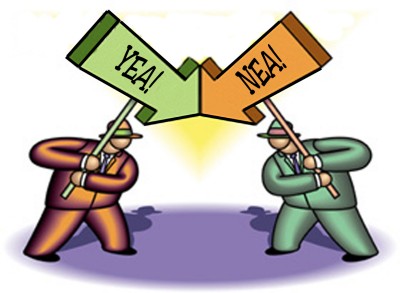 |
About Dr. Research and his work
Although
Dr. Research
and I disagree, it is not my desire to "discredit"
Dr. Research.
Nothing could be further from the truth.
I admire what
this Maryland-based researcher
does. From what I have been told,
Dr. Research
toils long hours in near-total privacy creating tumors in
mice and looking for ways to cure those tumors. This
is hardly what most of us would consider pleasant work.
However, I am
glad we have people like Dr.
Research willing to take on
this valuable task. He is society's warrior in the
fight against this dread disease.
Dr. Research
is not only exploring the origins of disease, but he is
constantly looking for vulnerabilities that can be exploited
to 'cure cancer'.
Although
progress in curing cancer has been painfully slow,
especially when compared to the dramatic speed with which
polio was cured, there have been several excellent recent
breakthroughs in the fight against cancer.
One development is the new-found ability to sequence
genomes. This means the entire genome of a tumor
profile can be processed in a few hours.
The second development is the advance
of computers. Science now has the ability to analyze tumor
profile data through very sophisticated computational structures and
artificial intelligence. Computing has become not just
faster, but much more sophisticated. Science has
reached a third generation artificial intelligence where
computers can think in a contextual way. Today's computers
will help doctors make treatment decisions based on vast amounts of
information.
These advances suggest the dawn of targeted gene therapy as a way to
treat malignancy. Gene therapy involves the engineering of
the body's own tumor-fighting cells to specifically target
malignant ones. We could be on the verge of a new era in
cancer treatment: Genetically modifying a patient's own
immune defense cells to fight tumors. From what I
gather, MD Anderson is about to open a new clinic that will
put these cutting-edge advances to good use.
Another advance is stem cell research.
Still in its infancy, medical researchers
anticipate that adult and embryonic stem cells will soon be
able to treat cancer by replacing diseased tissues with
healthy tissues. Today a number of stem-cell therapies
exist, but most are at experimental stages and very costly.
I wish to make
it clear that at no time have I ever doubted the sincerity
and integrity of most mainstream cancer research. Yes,
I have reported unethical behavior in the 1977 testing of
laetrile at Sloan-Kettering and
the 1995 testing of
Antineoplastons at the NIH,
but by and large I believe that people like
Dr. Research
are in the cancer cure game for the right reasons.
While I do
believe there exist unconscionable, amoral men who
manipulate developments in the cancer industry to suit their
own interests, I know there are countless well-meaning
doctors and researchers dedicated to finding a cure for
cancer.
I fully applaud
these modern developments in the War against cancer.
So what
is my beef?
I don't
understand why we can't have two chariots in the
race.
If a
simple herbal tea like Essiac could actually cure
breast cancer like they said it could, it is a crime
against humanity to deny access to cures like this.
My
Cancer Diaries have meant to show there have
already been several promising cures for cancer
destroyed by shadowy men. I want to make sure
the same thing doesn't happen to Dr. B.
|
 |
The
Origin of the Debate
Before the Great
Debate begins, let's review the letters that preceded it.
Dr.
Research:
Rick, I
grow weary of having you repeatedly malign the motives
of "the medical establishment" and the intelligence and
the commitment to the health of their patients of
physicians who do not agree with your point of view.
Rick
Archer:
Dr. Research, I have long
considered you to be a trusted advisor. Therefore to see
you capriciously brush me off over an academic matter
seems highly out of character for you. Yes, you are
correct… I am guilty of over-generalizing when I use the
term "medical establishment". But I clearly pointed out
on several occasions that my indictment is directed at
shadowy executives in the NIH, FDA, and pharmaceutical
drug companies.
My mistake pales in comparison to the doctors at
Memorial Sloan Kettering who deliberately falsified the
results of Laetrile tests and lied about their actions
to the American public in the Seventies. Or the
researchers at the NIH who deliberately sabotaged
Burzynski's trials in the early Nineties and filed
copycat patents in a blatant attempt to hijack
Burzynski's work.
I did not believe Mr. Skeptical when this issue came up
a year ago. I do now because I have done my homework.
My investigation in no way minimizes what you do for a
living. I for one am grateful for all medical research
and I completely support your personal efforts. But we aren't going
to get very far if science has to be compromised for
profits.
For example, I remember how you stated you wished
someone would submit their alternative cures to a
scientifically monitored double blind test. That would
be great if we could just count on people not to rig the
tests. The testimony of
Ralph Moss and
Dr. Li-Chaun Chen
made it clear there is corruption at work in the
research community.
What a shame it is that certain members of the research
community cannot be trusted. I have investigated two
promising cures - Laetrile and Antineoplaston - where
there is strong evidence that researchers deliberately
sabotaged results. When I see so-called "healers"
deliberately sabotage not just one, but an entire series
of legitimate holistic cures in order to protect the
cancer cash cow, I draw the line at these unethical and
immoral actions.
For the record, I am both intelligent and I am honest.
When I write a story that strongly suggests there are
people in the medical community that engage in behavior
I consider fraudulent and criminal, I would expect
someone with an open mind would investigate my claim
rather than dismiss me willy nilly.
But I am sure it is much easier for you to simply turn a
blind eye like everyone else… which demonstrates yet
again how these people continue to get away with what
they do.
Dr.
Research:
Starting with your previous posts, coupled with your
unnecessarily condescending/caustic response to my
PRIVATE e-mail to you with the transparent purpose of
provoking an argument, I think it best to exclude me
from any future of your "investigative" reports.
Rick
Archer:
Dr.
Research, I have the highest regard for your integrity.
I admire the work you do. I completely agree that
medical research to find a cure for cancer is valuable.
But you have chosen to take my heart-felt quest on a
personal level and pretty much ignored what I had to say
in the process.
There is something very sick in the cancer industry. The
word is 'corruption'.
Avoiding the truth of course is what everyone else does
as well, so join the crowd.
By the way, there is no such thing as a Private email.
Not in this world anyway.
I am not your
enemy. I sincerely hope that people like you
working within the 'System' will come up with a cure for
cancer. I mean that. For that matter, I hope you
are the one to find the cure for cancer. I know very
well that you are working hard towards a noble cause and
I applaud your efforts. I donate money to mainstream cancer research with this object in mind and I have
years of checks to prove it.
So if I do not oppose your work, then what is the
point of my articles?
All I want is one simple thing - I want the thugs in the
'Medical Establishment' to simply mind their own
business.
Lay off the strong-arm tactics and fight fair. Quit
trying to steal patents and quit spending $60 million
dollars in this senseless jihad to stop Burzynski.
Is it
asking too much to let two chariots enter the race
without one side cheating at every turn?
|
 |
 |
Furthermore,
in a perfect world it should not
matter who the "winner" is.
The goal should be to let everyone try to find a cure for cancer.
If someone succeeds, then the entire human race
wins. That is the way I see it.
Let
Burzynski go about his business without the constant
harassment. If the man is wrong, then let his failed
results speak for themselves. Like herbal tea and
apricot seeds, his cure isn't 'hurting' anyone, so leave
him to do his research in peace.
Is that
too much to ask?
Call off the attack dogs.
|
Dr. Research:
Rick, you couldn't be more
wrong on some points (and borderline insulting).
Yes, insulting, especially considering our respective
backgrounds in the field.
Once you've made up your mind
with the conspiracy angle, presenting the other side
with reasonable explanations runs into a brick wall.
But at the risk of being insulting,
Rick, you don't know what
you don't know. And, there is more at stake here
than switching milk brands.
I have underlined the
most disturbing paragraph you've written.
"Let
Burzynski go about his business without the constant
harassment. If the man is wrong, then let his failed
results speak for themselves. Like herbal tea and
apricot seeds, his cure isn't 'hurting' anyone, so
leave him to do his research in peace."
And I don't have the time to deal
with this; I have mouse
tumors to shrink.
Rick
Archer:
So, now that you have taken the
risk of insulting me - what is it that I don't know that
is so important? I have asked
you three times to tell me what you know about
Burzynski. Or were you just bluffing?
Dr.
Research:
"Or were you just
bluffing?"
That is the last straw.
You have called me a
liar. I spent the last 45 minutes on my almost-sent
message, carefully addressing your concerns, to be sent
soon, revealing the current research and views on
Burzynski's cure (some early results actually positive
regarding his HDAC inhibitor). But your ad hominem
attack just received, calling me a liar, has me move on
to better ways to spend my time, a.k.a. curing cancer
and having a life. I hope and pray your
articles do not cost lives.
Good riddance, for now.
Rick
Archer:
No one called you a liar. You
said that there were things I didn't know. I asked what
it was three times and three times you didn't deliver.
Considering you were attempting to be a stand up guy,
that doesn't exactly make your case, now does it?
And then you lost your temper.
The correct thing to do… and I mean this… is to quit
playing games and tell me what it is you think I need to
know.
Are you oblivious to the purpose of these articles?
For the record, these cancer diaries are directed at the
fact that my research strongly suggests certain
individuals at the top of the cancer industry food chain
are making so much money they are willing to sabotage
legitimate and far less expensive natural treatments. In
the rough and tumble world of competition, I suppose
there are all sorts of dirty tricks played. But this
isn't betamax versus VHS or Detroit versus electric car.
In the cancer industry, people are dying right and left.
No one wants to believe innocent lives have been
sacrificed to give your drug-based
technology an edge over its competitors.
But that is the way it looks to me. The problem is that
your technology has not come through yet.
Mainstream Medicine has been shall we say 'slow' to beat
this cancer problem. It clings to an obsolete treatment
mode - chemo radiation surgery -
that more and more people agree simply makes a
patient's last moments on earth painful and pathetic
while failing to significantly prolong lives.
I understand that the problem is complex and I was
infinitely more patient back in the days before I
realized that several possible cures been smashed to
smithereens by cancer industry goons. Now I am appalled
and ready to share my disgust with the world.
Burzynski is either going to
win a Nobel Prize for medicine someday or end up
completely discredited. I assume you expect the latter
outcome. But I would not
dismiss him so quickly. Burzynski might end up
proving you wrong.
IF it is true that any one out of
laetrile, essiac, gerson, rife,
hoxsey, burzynski ET AL had the ability to cure
cancer AND they were eliminated so cancer
industry fat cats could increase their obscene profits,
then the moral decay at the center of the cancer
industry just grows and grows and grows… just like the
cancer they are unable to cure.
As it appears to me, Burzynski is the latest in a long
line of alternative cancer fighters to have possibly
found a cure for cancer. What makes him much different
from the rest is that he started in the same place you
did - the cancer research lab.
Had he stayed within the
system, we might have our cure by now. But that's
another story. As it stands, rather than encourage the
man they once championed, the cancer industry fat cats
have used their government influence to spend
$60 million in one jury trial and $200 million
dollars overall to stop him
over a thirty year span.
Meanwhile, a long line
of desperate people are trying to go to his
clinic for the Treatment of Last Hope. There is
only one problem. The FDA has refused to let
anyone new receive the treatment. People are
climbing the wall with anxiety. They think they
are going to die without this treatment.
This is a simple example from the Team Hannah
website.
My name is Cornelia Doros and I was diagnosed in
2003 with Sclerosing Epitheloid Fibrosarcoma and
had 5 surgeries, one radiotherapy and one
cyberknife surgery.
As surgery is no more an option for me I went as
well to Burzynski clinic this year in February
2013.
They said the FDA has suspended use of
antineoplastons.
I am desperate to find your way or any other way
to get the treatment with antineoplastons.
Please contact me on the phone or email. Thank
you. (source)
I have two
reactions to this pitiful
email.
My first reaction is
further disgust at the FDA. This
woman is a real human being and
she is scared of
dying. The punitive actions of the FDA
towards Burzynski are ABSOLUTELY UNCONSCIONABLE...
...unless…
…. Unless the FDA
actually knows
something about Burzynski that is dangerous for
the American public… in which case the FDA is
doing their duty to protect us.
|
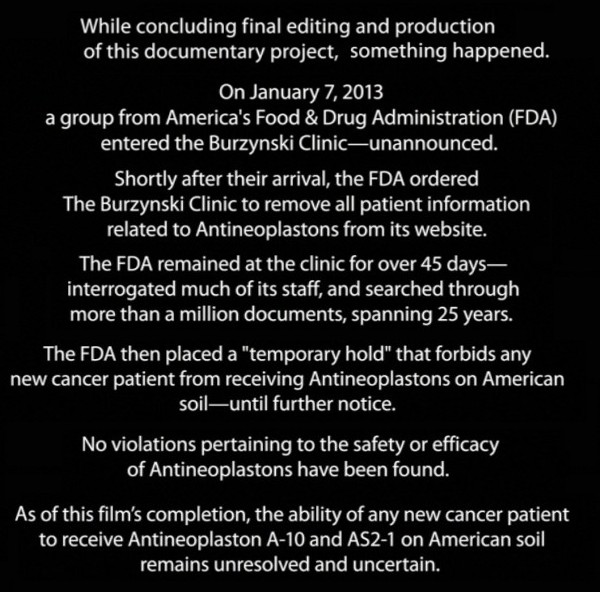 |
But since the FDA doesn't
bother to explain what they are protecting us from and
since the FDA has about as much credibility as a ham
sandwich ever since the
Burzynski Grand Jury monkey trials back in the Nineties,
I doubt the FDA has a legitimate reason to suspend Burzynski's treatment other than as a stall tactic.
As it appears to me, the FDA is behaving just as it
always does. By delaying the ANP treatment, the FDA
gives Medical Establishment cancer researchers - people
just like you - precious more time to come up with your
own cure.
I am about to tell the world yet again how disgusted I
am with FDA behavior. Here we
go again - two chariots and one side cheats at every
turn.
However, I have delayed my
story so far for four days because
you said
THERE IS SOMETHING I DON'T KNOW.
Based on my respect for your position as a
cancer researcher, I took your
word for it and postponed publication.
I assumed you were about to give me difficult-to-find
evidence that Burzynski is a FALSE HOPE and a dangerous
one at that. If that's the case, then yes, I will wait.
So what exactly is my agenda here? I have one single
goal. I want to get it right. I don't want to point the
arrow at Burzynski unless he is the real deal. No point
in setting desperate people up like that. Unlike certain
people in your industry, I have a fully-functioning
conscience.
You have stated loud and clear that you know something
important. Meanwhile desperate people are dying.
But now, just because you insist I did not show you
proper respect, you are going to take your precious
secret and hide it from the world. Your
attitude is basically "Rick called me a liar,
so fuck 'em, let them die."
Now how mature is that?
I assume you are familiar with the quote "evil
flourishes when good men do nothing".
The steady advance of Hitler
through 1930s Germany is typically listed as the most
alarming example of this 'see no evil, turn your back'
attitude.
I am writing this article based on that quote. I contend
there is GREAT EVIL within your industry and this fact
is being kept hidden from the American people. Someone
has to do something.
That said, I would never deliberately mislead Americans
to check out Burzynski if I knew something harmful about
the man. As it stands, I have not yet run across that
kind of information… but I concede that I am not nearly
in a position to be CERTAIN.
So I will ask you one more time… what do you know that I
need to know?
If Burzynski is a threat to the American people AND you
possess information that can demonstrate this, you have
a moral obligation to share that material.
If you don't, and Burzynski continues to harm helpless
patients, then that karma goes on you, not me.
(Rick
Archer's Note: To the credit of
Dr. Research,
he did indeed send me information. We will now
start the debate based on the response of
Dr. Research.)
|
|
The Burzynski Debate Begins |
Dr. Research:
You
certainly won't have to go as far as you and Burzynski had
to go; to find a lone anesthesiologist (yes,
anesthesiologist, not cancer researcher) in Japan. A PubMed
search (listing all published findings by a researcher) with
Hideaki Tsuda shows 4 articles written by him. One cell line
model tested, and one mouse model, which proves nothing
compared to humans. One paper looking at one patient (not
stastistically relevant), and one study with ten patients,
not curing the cancer, but mildly prolonging death (not
unusual for applying an HDAC inhibitor with some patients).
One researcher among the tens of thousands, and a few
emotional testimonies by patients in a movie he bankrolled,
is what you are betting the farm on??
PLEASE tell me you have more than that.
|
Rebuttal:
Note:
ANP = AntiNeoPlastons
Many medical scientists dismiss all cases of people cured using
ANP as being merely "anecdotal".
Their most common argument
is there is no hard evidence. (see
top picture at right)
The fact that
Burzynski has a growing legion of cancer survivors walking
around means nothing to them. Big deal. The scientists exclaim,
"anecdotal anecdotal anecdotal!"
Like his fellow
scientists, Dr. Research seems to dismiss the cancer
survivors seen in the two Burzynski documentaries.
"plus
a few emotional testimonies by patients in a
movie he bankrolled"
Hmm. Try
explaining the intelligence of that reasoning to the people
who are walking, breathing "anecdotal" proof that ANP
treatment saved their lives.
"One
researcher among the tens of thousands..."
Doctors and
researchers continually complain about the
absence of any randomized controlled clinical trials.
(see lower picture).
They ask why no
"peer review" studies are published. Why is there
only one researcher besides Burzynski as Dr. Research pointed out? And why does
this lone man have to be as far
away as Japan? Where is the valuable American research?
Well, for one
thing, anyone who dares do research on the pariah Burzynski
could easily see their career ruined.
Once they
(doctors)
receive their license, they must learn to walk a very fine line.
Even investigating unapproved therapies can cause them trouble.
Recommending them will mean peer ridicule, being ostracized by
the medical community and probably losing their medical license.
They have an enormous incentive to maintain the status quo,
namely, their large paycheck, emotional belief system,
personnel/professional credibility and career advancement.
(Gavin Phillips,
article)
|
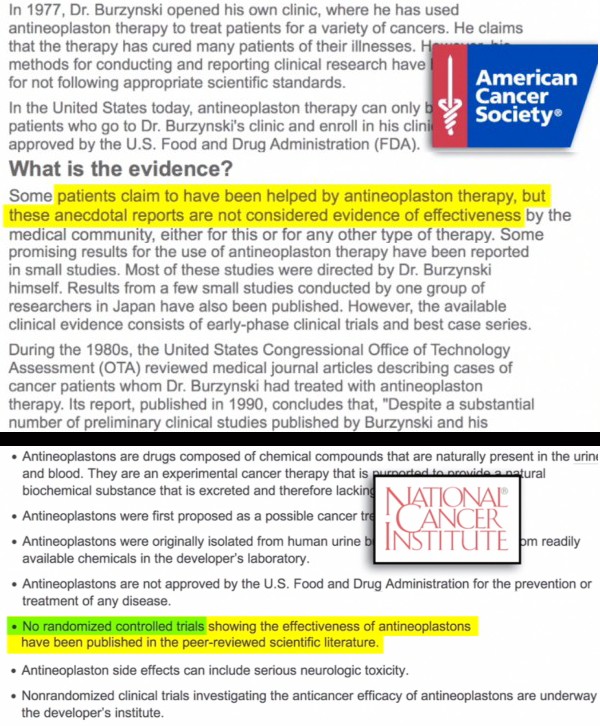
So the
question becomes, "Why haven't any randomized trials been
published?"
|
My guess is that
Gavin Phillips is right. No one researches Burzynski because
it invites almost certain career jeopardy. That would
explain why the only research found exists in a more "open
minded" research climate such as Japan
Meanwhile, the
second documentary suggested if
the journals would just let Burzynski publish his own
material, then he wouldn't be
quite so much a mystery. In
Chapter Three,
I pointed out that Dr. Oz was reluctant to invite Burzynski
on his show because there was so little information out
there.
"Dr. Oz
implied that he had little insight into what Burzynski
was doing because there wasn't much medical information
about Burzynski being published."
Burzynski has
indeed published scientific articles on his work in the
past. Unfortunately, Burzynski continues to run into a
serious roadblock - no one wants to publish his ongoing
work.
This is an old
tactic. In
Chapter Five, I pointed out how Morris Fishbein made
sure no one published Royal Rife. The one man who did
publish got a bullet through his windshield.
|
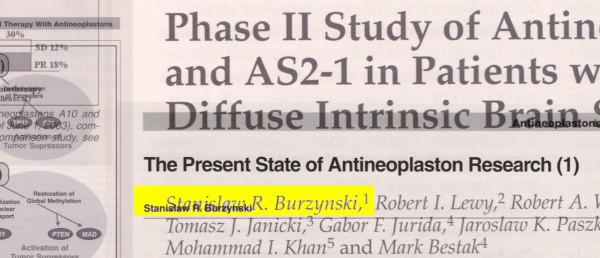
Conclusion:
The results of this study compared favorably with the
responses of patients treated with radiation therapy and
chemotherapy. The study continues with accrual of additional
patients. (2003,
source)
|
The second
Burzynski documentary offered compelling evidence that a
major reason there is not more Burzynski literature for
review is due to a deliberate suppression of his work.
According to the
documentary, in November
2012, Burzynski submitted a report of survival stories
ranging from 8 years to 16 years from deadly
Glioblastomas, brain cancer.
Ordinarily a
Glioblastoma is a rapid death sentence... 44 to 74
weeks according to the National Cancer Institute (see
picture).
Let's see, 74
weeks adds up to 1 year and 3 months.
And here
Burzynski was trying to submit a report that he was able to
successfully treat gliomas to the extent that he had patients who were still
alive eight to sixteen years later.
There is a big
difference between 74 weeks and 16 years. One would
assume a cancer researcher dedicated to prolonging lives and
finding cures would be curious about a report like this.
But these
researchers will never read about it. Why not?
|
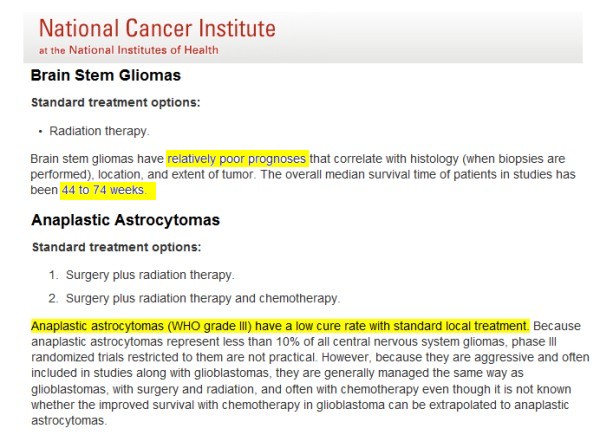 |
As this email
exchange shows, the Lancet Oncology Peer Review Team
rejected Burzynski's 2012 submission just two hours after it
was submitted.
Two hours.
That was kind of fast. Their reason for dismissal?
They decided the
message that ANP can cure fatal gliomas should be reported
elsewhere.
What did they
have in mind? The funny papers? Dear Abby?
This kind of
thinking is highly reminiscent of the story of Dr. Edward
Jenner, the man who cured smallpox.
Smallpox was the
most feared disease on earth. In 1796, Dr. Jenner discovered
he could cure smallpox by vaccinating people with cowpox, a
far less virulent form of the disease.
When Dr. Jenner
submitted his report to the Royal Society, they simply
rejected it. They refused to publish his findings.
In
fact, it took the Royal Society four years to
finally get around to testing Jenner's work. Imagine
their surprise when it worked.That kind of
attitude makes you want to scratch your head.
As it turned
out, Jenner's work was being held up in part by variolators,
practitioners of a crude and sometimes fatal form of
vaccination. These variolators were upset that their
business would dry up if Jenner's work proved true. (
read more )
But that was
way way back in the Dark Ages. Surely everyone is more
open minded now.
Surely in these modern times, a reputable source like the
Lancet would be completely above the political fray and
committed to publishing potential cures.
My favorite part
is just how polite the language is. Not only do they
refer to "Dear Dr. Burzynski", they encourage
him to try try again soon!!
"and hope
it does not deter you from considering us again in the
future!"
I call that
'Killing you softly with kindness'.
|
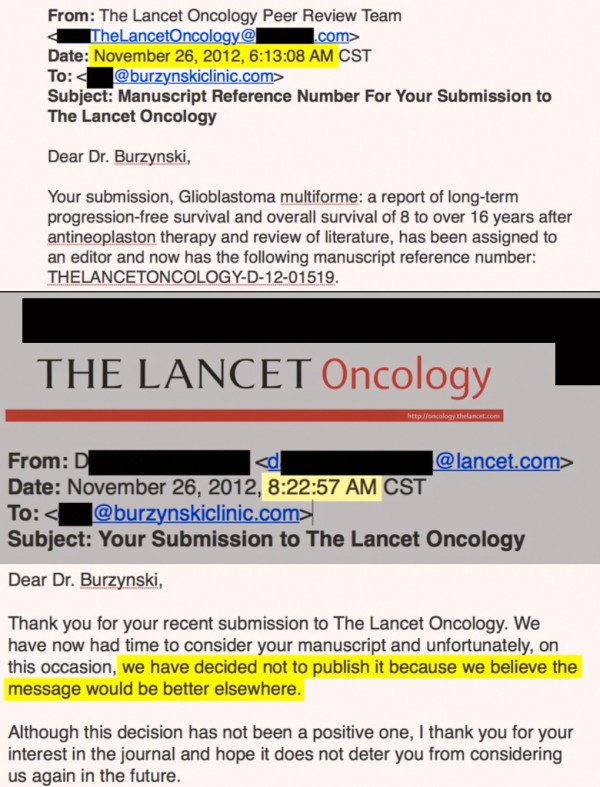 |
Dr.
Hideaki Tsuda
"One
researcher among the tens of thousands"
"to
find a lone anesthesiologist (yes, anesthesiologist, not
cancer researcher) in Japan."
Dr. Research
is referring to Dr. Hideaki Tsuda of Kurume Medical
University in Japan. Dr. Tsuda is a former colleague
of Burzynski at Baylor Research in Houston back in the
Seventies. He has studied antineoplastons for 27 years.
Dr. Tsuda was
interviewed in the second Burzynski documentary about his
work. This is what Dr. Tsuda said:
Science
must be born in doubt. An
anecdotal event produces the scientific mind.
"Anecdotal"
is very important, but if you report anecdotal,
anecdotal, anecdotal, it doesn't do anything
good, its not persuasive, it's not convincing.
|
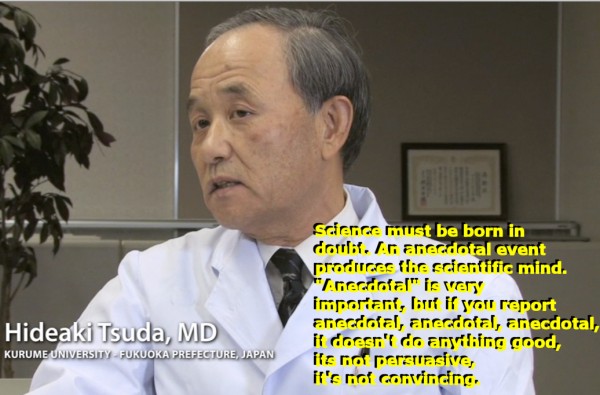 |
|
That
is why we did the randomized study.
The motivation - why we started
this research on ANP for the
last 27 years.
We did not believe
Dr. Burzynski blindly.
We wanted
to see and test very much the
effects of ANP with our own eyes and in our own ways.
PHASE ONE
We
did the Phase One studies first. Phase One establishes
safety. We wanted to know how much dosage the patient
could tolerate.
We used ANP A10 injection
formula and AS2-1 oral formula with 43 patients.
About 50% of these patients
were responding to this combination therapy with ANP A10
injection formula and AS2-1.
We
published the results from this
Phase One Clinical study in
1995 (see picture).
Since we found a better response in cancer of the liver,
we decided to concentrate our studies on liver cancer
studies.
|
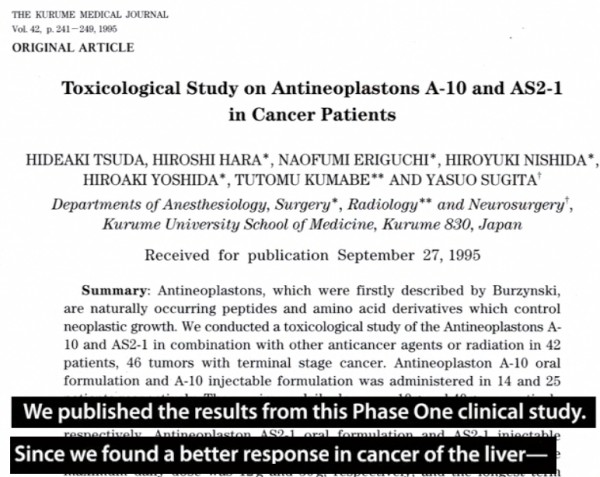 |
PHASE
TWO
We
then moved our research to Phase Two
clinical trials. Phase Two
establishes efficacy (effectiveness).
We
found that ANP could obviously prolong the disease free
interval and overall survival rate.
|
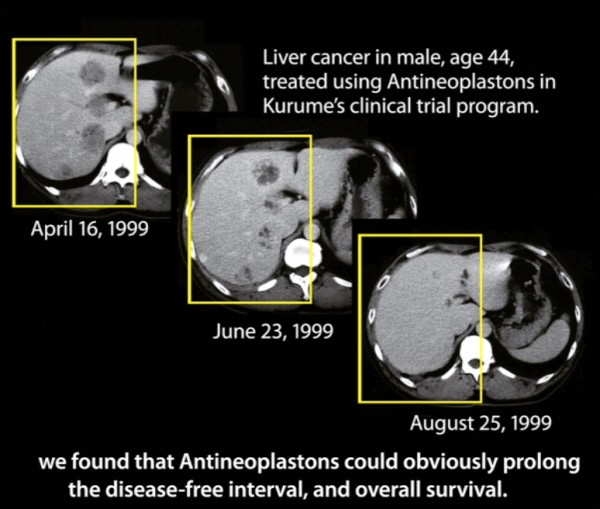 |
In
this Phase Two study we
subjected the liver metastasis from the primary colon
cancer. We divided the
patients into two groups - randomly, with a control -
and an ANP treated group.
32 patients in the ANP group
and 33 patients in the control group.
In the ANP group, we added ANP A10 injections in
the vein of the arm for one week and the AS2-1
capsules for at least one year in addition to the inter
arterial hepatic infusion of 5FU (chemotherapy).
In the control group, about
50% of the patients lived around 36 months. In the ANP
group, 50% of the patients lived about 70 months.
So
obviously ANP makes survival longer... about double.
The scientific community
invented the 'randomized study' to not only exclude any
anecdotal data, they are also avoiding bias.
This
has been done in Kurume University Hospital completely
independent from any other institute.
We
were not given any advice from Burzynski either.
This
is the way that the scientists should be.
First we doubt the data from
Burzynkski.
Then we tested it.
We
found that Dr.
Burzynski was right.
It's not obviously
"anecdotal"
anymore.
(Rick Archer's Note: Dr.
Tsuda's interview was taken from the second
Burzynski documentary. The documentary
is not currently available on the Internet for free,
so I went ahead and purchased a copy.
Please take my word for it that I
was careful to transcribe the interview correctly.
I do have one
comment about the 'scientific method' when it comes
to using humans.
I wonder how those people felt about being in the control group.
I doubt I would appreciate dying 34 months faster in
the interests of science.)
FOOTNOTE: AT THE
END OF THE SECOND BURZYNSKI DOCUMENTARY, DR. TSUDA
REVEALS THAT NO ONE WILL PUBLISH HIS WORK.
|
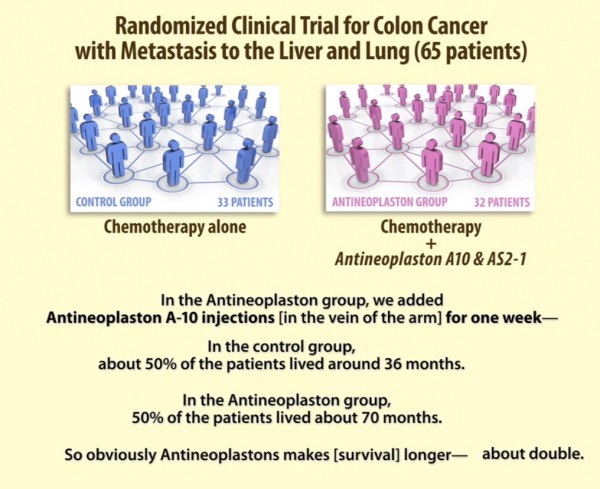
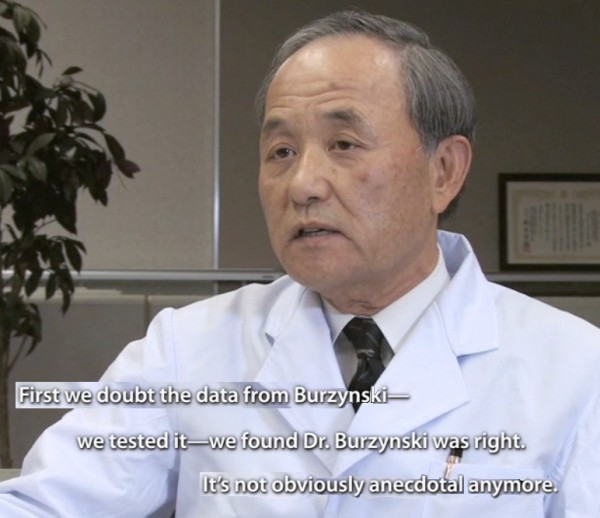 |
Burzynski's Patients
Speak up
|
Dr. Research:
One
researcher among the tens of thousands, and a few
emotional testimonies by patients in a movie he
bankrolled, is what you are betting the farm on??
PLEASE tell me you have more than that.
|
Rebuttal:
"anecdotal
anecdotal anecdotal".
Any time a
doctor or researcher doesn't agree with a position, they
typically trot out their favorite counterpoint:
“Anecdotal
evidence is worthless as scientific evidence!”
The problem here is that many phenomena in medicine and
nature can be observed, but not necessarily explained.
That doesn't mean it should be ignored and cast aside.
In my previous
Medical Mysteries Chapter, Ignaz Semmelweiss noticed
that a colleague died shortly after an accidental stab by a
knife in the autopsy room. The colleague died of the exact
same symptoms that had been killing all the women in the
clinic during childbirth. Now Semmelweiss could not
see the germs on the knife, but he guessed there had to be a
connection. The "understanding" of the
cause would come years later thanks to Louis Pasteur, but in the
meantime Semmelweiss was able to eliminate puerperal fever
simply by having the doctors wash their hands. Score
one point for "anecdotal". (Story)
In my previous
Medical Mysteries Chapter, Edward Jenner took note of
a folk wisdom that suggested milkmaids never get smallpox.
Noting that milkmaids frequently did get cowpox, a similar
but less virulent form of the disease, Jenner guessed there
might be a connection. Jenner cured the worst disease
in mankind at the time simply by making an anecdotal
observation and following a path to its logical conclusion.
(Story)
As a young
graduate student in 1967, Stanislaw Burzynski made an interesting
observation. One day Burzynski noticed that certain
particular peptides appeared less frequently in the blood
and urine of cancer patients than in healthy people. This
fortuitous observation got him thinking. What would
happen if he put these same missing peptides back in the
blood of cancer patients? He surmised that giving them
to cancer patients might help restore a sort of immunity.
Burzynski did not understand the reasons behind the
observation, but he was determined to at least explore the
possibilities. (Story)
Given the fact
that many medical discoveries have started with anecdotal
observation, it seems ludicrous to ignore curious situations
when they present themselves. Even if nothing can be
"proven" at the time, an army of walking talking Burzynski
patients should not be casually dismissed as "anecdotal".
"Anecdotal" is
not considered worthless by our society. Anyone with
common sense knows this. Courts of law consider
eyewitness testimony as admissible evidence. Employers
consider character references of friends and former
employers to be a useful predictor of a job candidate’s
likely performance. Marketing people conduct surveys to get
important useful information about the market. These are
simple examples where some degree of anecdotal evidence is
relied upon in everyday society.
It is only when
the stakes get higher that people want more proof. A
perfect example of justified skepticism is in regards to
paranormal events such as ghosts, UFOs, ESP, ETs and alien
abductions. None of these type of events can be proven
to a general audience because they are so rare. These
are "you gotta see it to believe it" situations.
That said, there
are guidelines for the "believability" of anecdotal
observation.
- The number
of eyewitnesses, testimonials and claims.
- The
consistency of the observations and claims.
- The
credibility of the witnesses.
- The clarity
of and proximity of the observation.
- The state
of mind of the witnesses.
- What the
witnesses/experiencers stand to gain from their
testimony or claim.
The two Burzynski documentaries are chock
full of amazing Burzynski success stories. When you
listen to these people talk, they can be very persuasive.
I came away believing their stories without hesitation.
Why? First
of all, they identified themselves and spoke without
hesitation on camera. They offered clear testimony
that they were once very sick, that their initial doctors
had told them it was hopeless, that they went to Burzynski,
and now, years later, they are doing fine.
What do they
have to gain? Hmm. Even Burzynski's worst
critics don't believe Burzynski is giving these people money
to testify in his behalf. There is not one hint of
insincerity in their voices to indicate they are "in on the
scam".
To me, when I
hear their tales of suffering and fear followed by the joy
at their recovery against all odds, it seems obvious they
wish to speak up because they believe Burzynski's treatment
saved them. They feel intense gratitude and wish to
help the man overcome the tremendous skepticism of the
larger Medical Community. That is obviously their
motive.
Now, as for the
Skeptics, I cannot help but distrust their motives. I
have now written SIX PREVIOUS CHAPTERS complete with one
"Anecdote" after another to prove my point that there are
ruthless people who are more than willing to eliminate
cancer cures that might threaten their own income.
It is difficult to get a man to understand something
when his income depends on his not understanding it .
– Upton Sinclair
|
When a
highly-trained German doctor like Max Gerson runs an
experiment that shows "Diet" of all things can cure
tuberculosis, when Albert Schweitzer, the leading
humanitarian of the Twentieth Century, steps up to say his
friend Gerson is a genius, and when a thug like Morris
Fishbein finds a way to discredit and destroy Gerson, I say
take a look at the relative "Credibility" of the witnesses
and figure out what each person stands to gain.
Gerson spent his
whole life curing people. Schweitzer spent his whole
life saving Africa. Fishbein spent his whole life
getting America hooked on tobacco. Now I may be little
more than a lowly Social Science major, but there are times
when someone even with a limited intellect such as myself
has to weigh all the "anecdotal evidence" and come to a
reasonable conclusion.
Yes, you may
call it a "Leap of Faith" if you wish, but I believe that
Max Gerson was destroyed because he was pursuing an
effective and inexpensive cure for cancer. But I
can't prove it.
And now we have
reached the IDENTICAL CROSSROAD with Burzynski.
I can't PROVE Burzynski is right. I can only
weigh the evidence in my own mind.
To me, unlike
the rigorously trained scientific community, I say
"anecdotal evidence" has value. When I see a
tear-stained Burzynski patient thank him for saving her
life, that has meaning and value to me. It must be my
soft-minded social science background.
To deny the
importance of these testimonials demonstrates that medical
skeptics are all about playing a closed-minded game rather
than being realistic. When confronted with reality
like an army of walking talking Burzynski cancer victims who
should be dead now, they continue to just fall back on their
favorite defense... “Anecdotal evidence is worthless as
scientific evidence!”
Eventually, the
naysayers lose credibility. People begin to simply
ignore them. It’s obvious that the critics either lack the
most basic common sense or they are in denial. Or
perhaps they are cynically playing a deliberate game of
obstinacy as a stall tactic. Let's rip the competition
and see if we can get rid of them while plodding our way to
our own "cure for cancer".
Personally
speaking, I found the testimony of Burzynski cancer survivor Jodi Fenton to be
inspiring (I have included her story below).
But then the
Skeptics argue that these warm fuzzy stories are obvious
manipulation by the Eric Merola, director of the two
documentaries. Their argument is identical to
Dr. Research
commenting on "a
few emotional testimonies by patients".
Can you even
imagine the mindset of someone who casually dismisses people
who cry on camera? I think if I escaped a near-certain
death sentence, I might get a little emotional myself.
But don't let me
convince you. Make up your own mind.
I say you should
decide for yourself about "anecdotal". You can always
go see the first video for free. All you have to do is click
Burzynski Documentary
I.
If you are in a hurry, hit 'fast forward'. Jodi Fenton
appears about 9 minutes into the story.
Ms. Fenton had a
type of cancer with a 13.9 month survival rate. Thanks
to Burzynski's treatment ("anecdotal", meaningless), Ms.
Fenton is alive and kicking not 13 months later, but 13
YEARS LATER AND GOING STRONG.
|
JODI FENTON - on
camera interview:
On May 15th of 2000, I was
diagnosed with an inoperable, stage three, anaplastic
astrocytoma brain tumor.
Following
my diagnosis I was told that I had six to eighteen months to
live. So I met with an oncologist here in Los Angeles and in
San Francisco, and they were telling me at that time—the
oncologist told me, that the protocol for me would be to do
Temodar® which is a chemotherapy, followed by a course
of radiation.
(On
screen-graphics: Temodar for Anaplastic Astrocytoma = 13.9 month median survival
rate
using this chemotherapy
[SOURCE: FDA/Schering-Plough Mar 2003 PPT])
I asked
them what that treatment would get me and they said maybe
five years. "Maybe five
years of life?"
|
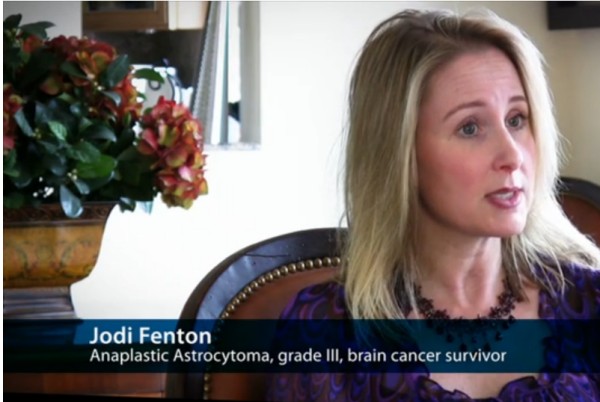 |
So of course I
asked what would happen after five years, if I get to that five
years and they said “well, we’ll see what’s available at that time”
meaning I would perpetually be on a course of treatment. Didn’t
sound good enough for me.
Also at that time I
had heard about Dr. Burzynski in Houston, and I found out about Dr.
Burzynski through a friend of mine. But I met with a prominent
neurosurgeon here [Dr. Keith Black of Cedars-Sinai]—who wrote off
Dr. Burzynski. Dr. Black told me point
blank that “antineoplastons don’t work”.
But Dr. Burzynski’s
treatment really sounded right to me. So I started on his treatment
on June 6 of 2000. In December of 2000, all that was left of the
tumor was scar tissue—and again, this was confirmed through an MRI.
On October of 2001, I stopped
Antineoplaston therapy altogether. I’ve had annual MRIs since that
time, so over the course of the last eight years, annual MRIs have
confirmed, all that’s left of the tumor is scar tissue—and I’ve been
off the treatment for that entire time.
Dr. Burzynski cured
me of a brain tumor.
[SOURCE: J
Fenton Med Recs PDF pg5-11; Third-Party confirmation PDF pg
12-13]
Transcript of Jodi Fenton's story
|
Dr.
Research:
And don't get
me wrong; there are many spirited debates in biology, in academic
and industry settings, including dozens of countries on what will
bring us closer to the cure (as in astronomy: are black holes needed
to form galaxies, is life possible on Mars, etc.). But these are
based on peer reviewed, independently verified data. Data
collected by testing with preclinical models (i.e. tissue culture
cells, mice, ...), and then clinical trials in humans, measuring
safety and efficacy. Bruzinsky has none of this bolstering his
"cure".
Rebuttal:
I can see the point of
Dr. Research.
Since I am not familiar with the research game, it never occurred to
me that men like Dr. Research
depend heavily on published research. Now I understand that
Dr. Research
doesn't believe in a Medical Conspiracy, but I do.
After studying the
tactics of Morris Fishbein in Chapter
Five, I realize it is possible to actually hide research
that is being done by threatening various publications with
retaliation were they to break any taboos. The story of Royal
Rife in Chapter Four
showed how Morris Fishbein was able to make the work of possibly the
greatest scientist in American history completely disappear from
sight.
If Fishbein can vaporize
Royal Rife, surely Fishbein's contemporaries can do the same thing
to Burzynski.
What the modern day
Fishbeins didn't count on was the arrival of Eric Merola, the man
who created the two Burzynski documentaries.
In Eric Merola's own
words:
"For me, perhaps the most stunning aspect of Part I is where
I was able to prove how the very same agencies trying to imprison
Burzynski for the rest of his life for "interstate commerce", were
also colluding with one of Burzynski's own research scientists as
well as The Department Of Health and Human Services to file
duplicate patents of already existing patents of one of his
Antineoplastons' medications, "AS2-1"!
For Part II, I wanted to make a modern story of the current
status of clinical testing of Antineoplastons. I also wanted
to roll the dice and follow patients from diagnosis, and throughout
their journey using Antineoplastons. Some of them came out
cancer-free, and some died.
I need to make it clear this therapy is not a "miracle cure" nor is
it in any way a "magic bullet". It works for some, and not for
others.
I concentrated more of my efforts in Part II on the progress
of the research. The most amazing of all in Part II -
for me - were my travels to Japan interviewing and meeting a team of
pathologists, oncologists, radiologists, surgeons, neurosurgeons,
PhD biochemists, and anesthesiologists at the Kurume Medical Center
in Fukuoka, Japan.
This team did something that no other medical research team has had
the courage to do, at least not at this scale. They underwent 27
years of independent studies of Antineoplastons, starting from mice
studies in the 1980's, then Phase 1 human trials (testing toxicity),
Phase 2 human trials (testing efficacy), and finally the first ever
randomized human clinical trials-for colon cancer with metastasis to
the liver, lungs and brain.
The "randomized trial" was created by the world's scientific
community to eliminate "bias" and "anecdotal data".
As Dr. Hideaki
Tsuda from my film says,
"Anecdotal
data gives birth to the scientific mind. But recording
anecdotal data again and again isn't convincing.
You have to create the randomized study where the
patients are arranged randomly and no one knows who is
getting just chemotherapy and who is also getting the
experimental medications (in this case,
Antineoplastons).
We did
exactly this, and after 27 years of independently
testing Antineoplastons, it's clear to us that
Antineoplastons are now considered a proven therapy, and its results can no longer be considered anecdotal."
What is
interesting about these Japanese studies is:
They were
truly independent, and were not done under Burzynski's
supervision or advice whatsoever.
|
 |
Speaking
to Burzynski about these monumental independent
randomized trials conducted by the Japanese, Burzynski
said,
"They didn't use the 24 hour infusions as I have
done since the 1980s, they only gave the patients one
week of arm injections of ANP, and then one year of oral
pills of ANP. If they
used the infusions as I have designed, their results
would have been far better."
While this is true that the Japanese ignored all of Burzynski's
recommended protocols for their human studies-and chose to design
their own, the fact that they had double the survival rate in the
Antineoplaston group vs. the chemotherapy alone group-that is pretty
darn incredible.
I can only imagine how the patients would have fared under the
infusions. What is also remarkable about these Japanese studies is
the fact that this medical team are not "alternative" scientists,
they are orthodox medical doctors and scientists. And as such, they
insisted on combining chemotherapy with both the control and
Antineoplaston groups.
The Japanese insist that Antineoplastons work very well in
connection with chemotherapy-as chemotherapy is "reactive" and
"kills", while Antineoplastons are "non-reactive" and "occupy the
space and reprograms the cells". They feel that the easiest way to
ease Antineoplastons into the mainstream medical profession is to
start there - combine it with chemotherapy.
In some ways I agree from a "paradigm-shift" stand point. Telling an
oncologist to throw his chemotherapy into the garbage and start
using only Antineoplastons overnight - from a bureaucratic
standpoint - is next to impossible. This Japanese oncology medical
research team firmly feels that Antineoplastons are a perfect
complement to standard chemotherapy."
[ SOURCE -
Trust Movies Interview ]
As Dr. Tsuda
made clear at the end of the second Merola-directed
Burzynski documentary, no one will publish his work. That
explains why Dr. Research
found absolutely no evidence of the Tsuda material that I
have reproduced in this article.
If it wasn't for
Eric Merola, the information on Dr. Tsuda would be
completely vaporized from the American medical landscape.
Thanks in large
part to Eric Merola, the Burzynski genie was out of the
bottle. No matter how many nasty things Wikipedia and
the other critics could say about the doctor, Burzynski's
story was finally out there.
Dr. Oz admitted
he would have never given Burzynski
a second thought
had not Emily, his mother in law, and Lisa, his wife,
ganged up on him and forced him to watch the first
documentary.
That is when Oz
changed his mind. Likewise for me. I followed
the lead of Dr. Oz and took a look myself.
|
 |
In other words, the
entrance of Eric Merola into Stanislaw Burzynksi's life was the
biggest break the doctor had gotten in a long time. Merola did
such an effective job with his first documentary that Burzynski
became an instant folk hero.
Considering the
oppression that Burzynski had been facing, one has to wonder why he
got the big break and the others didn't. Where was Merola when
Royal Rife, Harry Hoxsey, Max Gerson, laetrile and Rene Caisse were
being steamrolled into thin air?
One can only assume that
modern technology has made it much more difficult to suppress
information. But that is a topic for another day. For
now, one can simply be amused that the faceless conspirators are
scrambling. To stoop so low as to print that Burzynski
received the "Pigasus Award" for fraud in Wikipedia shows how
desperate they have become to put the genie back in the bottle.
Well, my guess is that
as long as Merola's documentaries continue to circulate, the
Conspirators could be in trouble.
Here is an example of
how effective Merola's work is. Both Burzynski documentaries
provided statistics on cancer survival rates in the deadliest forms
of the disease. Here is a narrative taken from the first
Burzynski documentary.
NARRATOR
(Eric Merola):
If we review Jodi Fenton’s medical records, who was known at
this time as Jodi Gold before she was married in 2005—it shows
she underwent an MRI at St. John’s medical center in Los Angeles
on May 11th of 2000, where they found a two centimeter mass,
which they suspected was cancer. The pathology department at St.
John’s performed a biopsy four days later, and confirmed that
she did indeed have a malignant brain tumor.
[SOURCE: J Fenton Med Recs
PDF pg 2-9]
Ordinarily the FDA requires
that anyone that wished to be a part of Dr. Burzynski’s trials,
must first have already undergone chemotherapy and radiation—and
failed. However, since Jodi’s tumor was so aggressive and her
prognosis severely grim, she managed to get "special exception
status" to be placed into this trial without undergoing any
other prior treatment whatsoever. [SOURCE: J Fenton Treatment
Summary]
An MRI on June 1st of 2000, revealed the size of the enhancing
portion of Jodi’s tumor, which was the part of her tumor that
was the most aggressively growing. On June 6th, she started
Antineoplaston treatment, and by July 3rd, only a month after
starting treatment the enhancing portion of her tumor was gone.
Her tumor remained non-existent up until October of the
following year, when she stopped her antineoplaston therapy
altogether. [SOURCE: J Fenton Med Recs (same as above)]
It’s one thing to be shown a
single anecdotal case with this type of brain tumor, and it’s
another to simply compare clinical trial data of inoperable
anaplastic astrocytoma patients treated with toxic radiation and
chemotherapy, versus, clinical trial data using only Dr.
Burzynski’s non-toxic Antineoplaston therapy.
A 2005 clinical trial report using only radiation and
chemotherapy, found that 5 of 54 patients, or 9%, were
cancer-free at the end of treatment.
[SOURCE:
Schering-Plough 2005, PDF pg 5]
While a 2008 clinical trial report using only Antineoplastons,
found that 5 of 20 patients, or 25%, were cancer-free at the end
of treatment—with no toxic side-effects. Jodi Fenton is one of
them
[SOURCE:
Neuro-Oncology 2008]
|
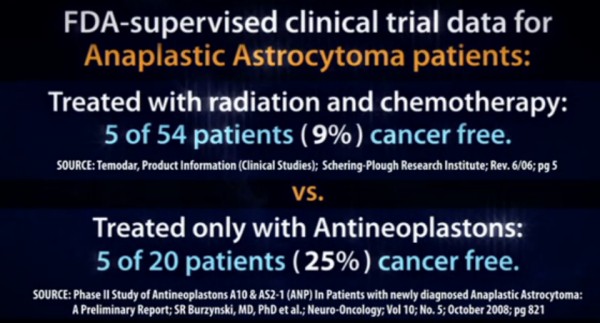 |
| |
|
Dr. Research:
And
don't get me wrong; there are many spirited debates in
biology, in academic and industry settings, including dozens
of countries on what will bring us closer to the cure.
But these debates
are based on
peer
reviewed,
independently verified data.
Data collected by testing
with preclinical models (i.e. tissue culture cells, mice,
...), and then clinical trials in humans, measuring safety
and efficacy.
Bruzinsky has none of this bolstering his "cure"!!
The mistake,
of course, is to have thought that peer review was any more than
a crude means of discovering the acceptability — not the
validity — of a new finding. Editors and scientists alike insist
on the pivotal importance of peer review. We portray peer review
to the public as a quasi-sacred process that helps to make
science our most objective truth teller. But we know that the
system of peer review is biased, unjust, unaccountable,
incomplete, easily fixed, often insulting, usually ignorant,
occasionally foolish, and frequently wrong.
– Richard Horton
|
|
Rebuttal:
Here are some
more of the comparative
statistics posted in the first Burzynski documentary.
Now one should
be careful. David Gorski, one of Burzynski's leading
critics, has warned everyone that the first documentary was
full of "distortions,
salesmanship, and exaggerations that a typical late night
infomercial uses."
(source)
(see
#1 picture)
Maybe so.
But for the sake of argument I will continue anyway. About 12 minutes
into the movie, we were shown a comparison between the
effectiveness of standard cancer treatment versus Burzynski
antineoplastons.
Anaplastic
astrocytoma is a fancy name for a brain tumor. The
statistics on the
survival rate show this is a type of cancer where basically no one
survives. One typically has about a year to live upon
diagnosis. The survival rate for anaplastic
astrocytoma past five years is close to zero.
(see
#2 picture)
When it comes to
statistics for Burzynski's antineoplaston therapy, a first
glance at the numbers in the chart on the right are not
every encouraging. A 25% cure rate doesn't
leap off the page and make us cry for joy.
But when you
compare 25% to Zero, then you begin to think twice. For
anyone to survive at all is a medical miracle. Previously
everyone died. Burzynski is able to save a few.
One of the interesting
features about the first documentary is that Eric Merola, the
director, assumed that people would not trust his work.
He actually anticipated people like Gorski would challenge
every single detail. So Merola went to the extraordinary length of posting the source
of every single one of the documents show in the Documentary
on the Internet.
In Merola's own
words:
The
entire film is backed up and sourced for transparent
fact-checking by anyone—including the
copycat patent situation. Every document used in
the film is available—in
context—for anyone to scrutinize and fact-check for
themselves. I knew I had to back up everything in this
documentary since most people would find corruption of
this magnitude simply too hard to believe at face value.
Eric Merola was
right. One of David
Gorski's criticisms of the documentary was that it was full
of distortions and exaggerated claims.
(see
#1 picture)
Based on
Gorski's
criticism, I decided I would personally fact-check this "medical
miracle" statistic myself.
So I went to the
transcript provided by Merola and took a look. I have
listed each source so any reader may duplicate my
efforts.
The source for
all of these statistics can be found in
Chapter Two of Merola's accompanying transcript.
Look for
this section near the top of the page:
3.
A 2005
clinical trial report using only radiation and
chemotherapy, found that 5 of 54 patients, or 9%, were
cancer-free at the end of treatment
[SOURCE: Schering-Plough 2005, PDF pg 5] (see
#3 picture)
3. While a
2008 clinical trial report using only Antineoplastons,
found that
5 of 20 patients, or 25%, were cancer-free at
the end of treatment—with no toxic side-effects.
[SOURCE: Neuro-Oncology
2008]
(see
#4 picture)
Note:
Jodi Fenton was one of
those
five survivors. We will read about her story in a
moment.
As one can see,
I posted what I found. Eric Merola told the truth on
every statistic. Only 9% survived using traditional
radiation and chemotherapy. 25% survived using
Burzynski's treatment.
My first
point is that this key statistic presented in the movie
checked out. This was a good showing for a documentary
accused of
"distortions, salesmanship, and exaggerations."
In my opinion,
this simple test increased Merola's credibility while
diminishing Gorski's credibility.
My second point
is that a 25% cure may not seem impressive, but it clearly
outperforms the standard methods of treatment. A 9%
score for chemotherapy is certainly nothing to brag about.
I sometimes wonder would
what would happen if Burzynski was left alone from all the
legal harassment and FDA obstruction to perfect his cure.
Perhaps with time and practice, he could improve on that
number.
Our final
statistic deals with Brainstem Gliomas.
Brain stem
tumors are perhaps the most dreaded cancers in pediatric
oncology, owing to their historically poor prognosis, yet
they remain an area of intense research.
These are the
pitiful little kids with the bald heads who are doomed to
die. It is uncommon for a child with a tumor in this
location to live longer than 12 to 14 months after
diagnosis.
As the chart suggests, not one
child treated with
standard chemo and radiation made it to five years.
(see
#5 picture)
On the other
hand, Burzynski had
total cures lasting over five years with 11 out of 40
patients. He gave 11 kids their lives back to them. If this doesn't
get your attention, nothing will.
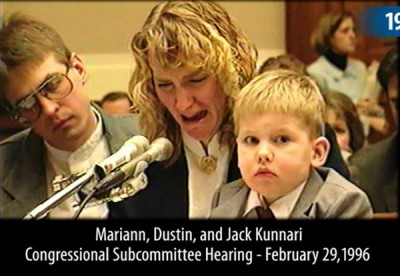
But these debates are based
on peer reviewed, independently verified data.
Bruzinsky has none of
this bolstering his "cure"!!
I can't help but
wonder what Dr. Research
would say about this data.
Incidentally,
Eric Merola posted a "Frequently
Asked Questions" feature on his documentary website.
There is a
wealth of information about Burzynski that can be found
there. Included are answers from Merola debunking some
of the common misconceptions about Burzynski.
|
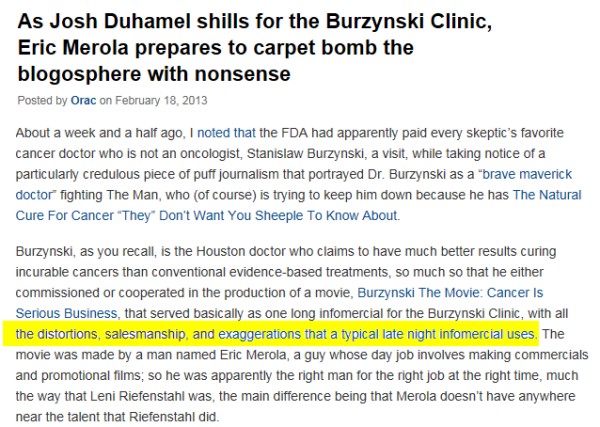
1. David
Gorski slams Merola.

2.
Anaplastic Astrocytoma: 44 to 74 week survival rate

3. Source:
Transcript Chapter Two

3.
SOURCE:
Schering-Plough 2005, PDF pg 5
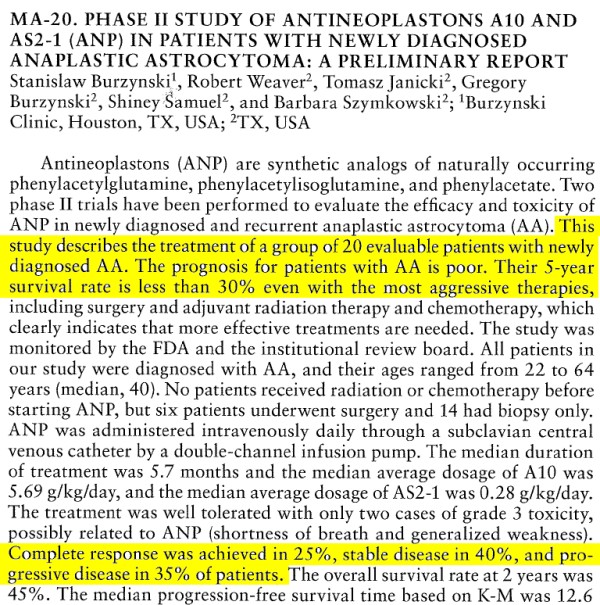
4.
SOURCE:
Neuro-Oncology 2008
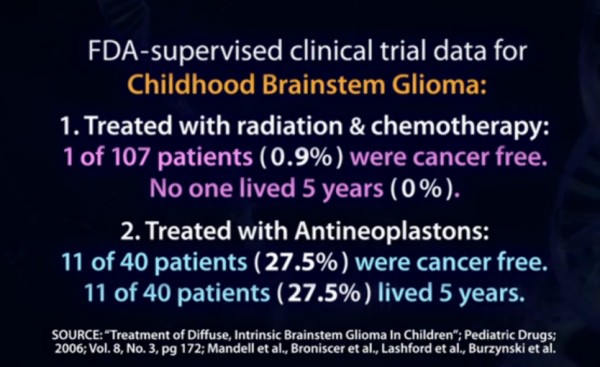
5.
SOURCE:
Pedatric Drugs 2006 PDF pg 8] |
Dr. Research:
And
the conspiracy angle you speak of
is ludicrous considering the number of people and
governments that would have to be involved.
Rebuttal:
I cannot PROVE
that there is a conspiracy. But I say ask yourself
again why our government would go to the trouble of spending
$60 million dollars to prosecute someone for the crime of
letting patients take cancer treatment home with them?
Royal Rife,
Harry Hoxsey, Max Gerson, Morris Fishbein, Laetrile, Essiac...
I think anyone with the ability to connect the dots will see
the pattern here.
If a patient can
legally receive treatment in Burzynski's clinic, why should
it be illegal for them to take it across State Lines to
continue the treatment in the comfort of their own home?
And even if it
is technically "illegal", so what? Ask yourself this
question, "Who cares enough to enforce this rule?"
Obviously no
one on earth cares! You don't care and I don't
care... but somebody does. Who are they?
Someone cares
to the tune of $60 million dollars! And who would
that be?
The answer would
be whomever would lose the most if the Burzynski treatment
was legalized for general use. The answer would be
whomever would benefit the most if Burzynski and his
treatment were to go away.
I contend that
Burzynski's innovative treatment is so dangerous to the
pharmaceutical drug industry and the cancer industry that he
has been targeted and harassed at every turn for the past 35
years. $60 million dollars is just the tip of the
iceberg. When one adds up the price tag for all the
trials over 35 years, the government has spent $200 million
dollars trying to shut this man down. And they won't
stop until they succeed.
"It took me years to realize that the people in
control of the cancer treatment world today did not want
a simple, quick cure for cancer. It was not in their
economic or career interest. They want complicated
disease syndromes and all the paraphernalia of
techniques, expert analysis, peer group conferences,
papers, discussions, research grants and clinical trials
for years before a new cancer therapy might be allowed.
It is a horrendous crime which serves only those on the
"inside" who are playing the great, lucrative "expert"
game."
- Barry
Lynes, author of "The Cancer Cure That Worked" p.
126 (the story of Royal Rife)
|
|


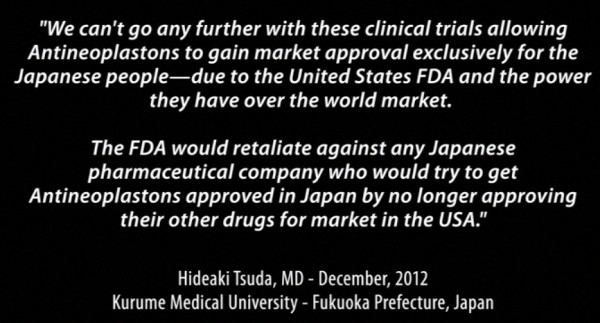
 |
And they say there's
no Conspiracy??
|
|
Dr. Research:
And
even Bruzinski knows what he's working with now.
It turns out the key molecule Bruzinski "discovered"
a few decades ago is a HDAC inhibitor, though he didn't know
it at the time. I know this class of compounds well, working
with them (and others) at the company I was at. And there is
some mild improvement with treatment when combined with
other treatments.
In
fact clinical trials are going on now with that class of
compounds, though the HDAC inhibitors used these days are
improved over Bruzinski's. They are not a very effective
treatment though considering the number of genes they
target. So, he may have serendipitously helped a few
patients early on (I'll be generous here), given at the time
the alternative cancer treatments available today weren't
available back then. Yet even his best case study files lack
the histology to prove conclusively that his treatment
worked, or that the patient was already cured by prior
treatment, and during his treatment, the scar tissue was
simply receding. And of the few cases he showcases as his
success stories, how about the thousands not mentioned. 3/6
people cured would be miraculous. 3/60 somewhat noteworthy.
3/600 or 3/6000, nothing more than a placebo. His inability
and reluctance to produce complete case studies of all his
patients makes one believe the last case numbers. We need to
know what is called the denominator (number of people
treated). And this is always done
with a randomized group for true verification. Bruzinski's
trials are not randomized.
As I
mentioned above, his "miracle cure" is a well known HDAC
inhibitor. BTW, currently sold by a number of pharmaceutical
companies (It's believed he currently buys his own stock
from China), and can be prescribed by any medical doctor out
there. So though Bruzinski may have stumbled onto something
that has mild efficacy early on, Others then discovered what
the small molecule responsible was. This is where, in my
opinion, Bruzinski turned. He realized he had no "angle" any
more. So he began calling his molecule (again, commercially
available elsewhere, with better types these days out there)
"targeted therapy". This is bullshit since HDAC inhibitors
target well over a hundred genes. So, to make an even better
selling point, he added in his arsenal 20+ already FDA
approved targeted drugs. So, he has no magic bullet or cure.
He is relying on cocktails of already FDA approved (ironic,
isn't it) drugs.
What makes his current approach truly insidious is the
following:
1)
He looks at biomarkers (proteins expressed) to determine
what cocktail to give a patient (as many of us in the field
do), but he unexplainably often uses results found in other
tissues. Not the cancer Bruzinski is treating. For example,
if he's treating liver cancer, he may use a biomarker that
was looked at in a breast cancer. Very dangerous and
irresponsible to compare two different tissues like this.
2)
Drugs are mixed together willy nilly by him without testing
for toxicity and efficacy beforehand. This is important.
Successful targeted therapy to date, is approved by the FDA
on particular tumor types with proper controls and safety
standards using one drug at a time (though well thought out
combinations are starting to be looked at in properly
controlled studies). Unstudied combinations of drugs can
severely affect the MOA (mechanism of action) of the
original drug, and possibly result in dire consequences for
the patient because of interactions among the biological
pathways affected by each drug in his cocktail. Burzinski's
"throwing everything but the kitchen sink" approach for the
patient is untested, unsafe, and unethical. BTW, this may
help explain why there is such a high withdrawal rate of
patients from his studies, indicating very toxic side
effects. And because it's a mixture, each individual drug
has to be at lower than optimal doses. Treating with
standard care with the one key drug at optimal dose yields
the best, proven result. But then Burzinski's cocktail angle
is gone, and he would have nothing new to offer patients
that they couldn't get at a conventional hospital.
Rebuttal One:
I
personally do not have a
"medical"
rebuttal for anything Dr. Research has said here.
I do not question that he possesses advanced medical
expertise. After all, this man received a
degree in the highly complicated field of Cellular
and Developmental Biology.
|
The
problem with the Medical Civil War is that
people in
Dr. Research's
own field do not agree with him. For example, there is contradictory evidence for his
claims that comes from within the same medical
research community in which
Dr. Research
works. Back in the early Nineties a
fellow cancer researcher named Dr. Dvorit Samid filed
11 ANP patent applications. These "copycat
patents" were directly supported by none
other than the National Cancer Institute as
part of the Department of Health and Human Services.
On
Page 54 (of 111) in Patent 5605930,
Dvorit Samid stated that the antineoplastons
that she had researched did indeed work.
In her own words, several deadly cancerous
conditions ARE TREATABLE BY THIS METHOD.
(see picture)
In other words,
Dr. Research
is contradicted by a fellow cancer researcher. I might
add that to my knowledge, Dr. Research
has never worked with ANP.
On the other hand,
Dvorit Samid did her work
DIRECTLY
WITH ANTINEOPLASTONS.
So which
highly-trained cancer researcher are we supposed to believe?
|
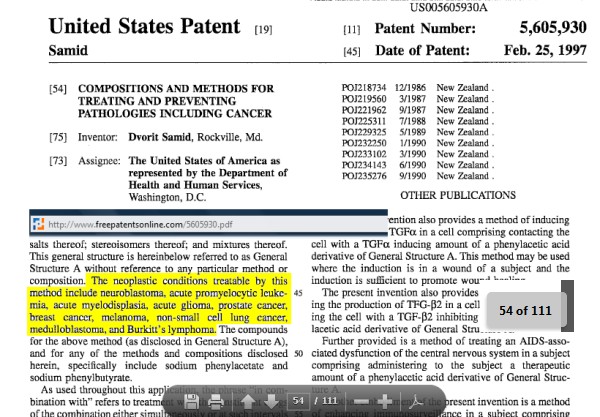 |
Rebuttal Two:
Rick
Archer's Note: A medical researcher here
in Houston read my article and offered a few words.
His replies are listed
in purple.
|
|
Dr. Research:
And even Bruzinski knows
what he's working with now. It turns out the key
molecule Bruzinski "discovered" a few decades ago is a
HDAC inhibitor, though he didn't know it at the time. I
know this class of compounds well, working with them
(and others) at the company I was at. And there is some
mild improvement with treatment when combined with other
treatments.
Dr. Research
definitely displays a negative bias of Burzynski/Bruzinski.
I found Dr. B’s work remarkable in that he had
identified the absence of a group of peptides and
correlated that with cancer patients. Good catch.
I recall in all the reading that another research
center had noted the absence of these peptides but
never made the connection. I’m not sure when Dr.
B’s first made this discovery but our analytical
capabilities have increased by leaps and bounds, so
today we can be blasé and say these are HDAC
inhibitors whereas back then we probably did well to
identify them more generically as a subgroup of
peptides having no knowledge of HDAC inhibitors.
In fact clinical trials are
going on now with that class of compounds, though the
HDAC inhibitors used these days are improved over
Bruzinski's. (Well,
yeah! The state of the art has increased
substantially.)
They are not a very
effective treatment though considering the number of
genes they target.
I assume that more than
one research study was performed to establish the
efficacy of HDAC inhibitors. Obviously at the time
someone felt there was value in exploring these
compounds as a possible treatment for cancer and
come to the conclusion that they were “not a very
effective treatment.” In research, you win some and
you lose others. There has been an immense amount
of cancer research that has come to similar dead
ends.
So, he may have
serendipitously helped a few patients early on (I'll be
generous here), given at the time the alternative cancer
treatments available today weren't available back then.
This looks like an
admission – begrudging – the Dr. B was ahead of the
current state of cancer treatment at the time. So
what is the problem?
Yet even his best case study
files lack the histology to prove conclusively that his
treatment worked, or that the patient was already cured
by prior treatment, and during his treatment, the scar
tissue was simply receding. And of the few cases he
showcases as his success stories, how about the
thousands not mentioned. 3/6 people cured would be
miraculous. 3/60 somewhat noteworthy. 3/600 or 3/6000,
nothing more than a placebo. His inability and
reluctance to produce complete case studies of all his
patients makes one believe the last case numbers. We
need to know what is called the denominator (number of
people treated). And this is always done with a
randomized group for true verification. Bruzinski's
trials are not randomized.
This is clearly a
weakness on the part of Dr. B. As I have stated,
when counseling a patient about any type of
treatment or procedure the responsible and legally
binding responsibility is to present the pros and
the possible cons so that the patient has enough
information to make their decision. We call that
Informed Consent and we in medicine are legally
bound to present that information before any
procedure. NOT AN OPTION.
As I mentioned above, his
"miracle cure" is a
( now! ) well known
HDAC inhibitor. BTW, currently sold by a number of
pharmaceutical companies
So if it is of no value,
then why are – not one but several –
pharmaceutical companies
going to the considerable expense of manufacturing
them? Perhaps since it targets so many other genes
there is value beyond the cancer treatment aspect.
It's believed he currently
buys his own stock from China), and can be prescribed by
any medical doctor out there. So though Bruzinski may
have stumbled onto something that has mild efficacy
early on, Others then discovered what the small molecule
responsible was. This is where, in my opinion, Bruzinski
turned. He realized he had no "angle" any more. So he
began calling his molecule (again, commercially
available elsewhere, with better types these days out
there) "targeted therapy".
I don’t know the
year-to-year historical context here to decide
whether Dr. B realized that he no longer had an
angle. This presupposes that Dr. B was not
interested in helped cancer patients but was more
focused on making a profit from his treatment.
This is bullshit since HDAC
inhibitors target well over a hundred genes. So, to make
an even better selling point, he added in his arsenal
20+ already FDA approved targeted drugs. So, he has no
magic bullet or cure. He is relying on cocktails of
already FDA approved (ironic, isn't it) drugs.
Maybe. Dr. R
presupposes that Dr. B was trying to maintain a
marketing angle. I did take note that nurse
Rene Caisse felt the need
to “improve” upon the original Native American
recipe and added four additional ingredients to the
original four ingredients. Did that really improve
its effectiveness or was this just an attempt to
supersize her product.
What makes his current
approach truly insidious is the following:
1) He looks at biomarkers
(proteins expressed) to determine what cocktail to give
a patient (as many of us in the field do), but he
unexplainably often uses results found in other tissues.
Not the cancer Bruzinski is treating. For example, if
he's treating liver cancer, he may use a biomarker that
was looked at in a breast cancer. Very dangerous and
irresponsible to compare two different tissues like
this. (Dr. R is
correct. I can’t imagine Dr. B’s rationale.)
2) Drugs are mixed together
willy nilly
(judgment call – is this substantiated somewhere)
by him without testing for
toxicity and efficacy beforehand. This is important.
Dr. R is absolutely
correct about current practice. Early research was
a lot of wandering in the dark. Current research is
much more targeted in order to evaluate what is most
effective. I think there is a lot of value to
this. May be slower but the process yields more
information which can be applied to subsequent
research.
Successful
targeted therapy to
date, is approved by the FDA on particular tumor types
with proper controls and safety standards using one drug
at a time (though well thought out combinations are
starting to be looked at in properly controlled
studies). Unstudied combinations of drugs can severely
affect the MOA (mechanism of action) of the original
drug, and possibly result in dire consequences for the
patient because of interactions among the biological
pathways affected by each drug in his cocktail.
Burzinski's "throwing everything but the kitchen sink"
approach for the patient is untested, unsafe, and
unethical. BTW, this may help explain why there is such
a high withdrawal rate of patients from his studies,
(what is the basis
for this statement?)
indicating very toxic side effects. And because it's a
mixture, each individual drug has to be at lower than
optimal doses. Treating with standard care with the one
key drug at optimal dose yields the best, proven result.
But then Burzinski's cocktail angle is gone, and he
would have nothing new to offer patients that they
couldn't get at a conventional hospital.
In
my opinion, Dr. Research’s
case suffers due to his obvious bias.
Nevertheless, Dr. B’s
failure to provide informed consent and his failure
to give a rationale as he modifies his treatment are
serious negatives. When Dr. B got started the state
of all cancer research resembled “willy nilly” yet
progress was made. For example, genes were hardly
understood back then. The state of the science has
advanced light years since then but Dr. B does not
appear to have kept up with the times and still uses
the old way of doing things. It may help with
treatment – it may not, we do not know – but it does
not help advance the science. Remember, the
independent Japanese studies only evaluated the type
of cancer that Dr. B’s treatment had been most
effective against. It was shown to have some
benefit but Dr. B’s treatment extended life but was
not a cure and there were plenty of patients whose
cancer did not respond.
|
|
THE
MEDICAL CIVIL WAR REVISITED
I am reminded
again of what Dr. Oz said regarding the Medical Civil War.
“You find the arguments that support your
data,” Oz said,
“and then it’s my fact versus your fact.”
As the reader
may remember, after the Grand Jury monkey trials of 1997,
all charges were dropped against Burzynski.
From that point
on, Burzynski was allowed to participate in FDA-approved
clinical trials. By definition, all drugs within FDA
clinical trials are considered experimental. That is the
entire purpose of an "experimental FDA clinical trial". All
drugs on the market today, without exception, had to pass
through a series of FDA clinical trials. They were all
considered "experimental" before approved for public use to
be later considered "standard treatment".
Due to his
renegade status, over the years Burzynski has encountered
multiple delays and roadblocks in the testing of his
treatment.
At this point,
Burzynski's antineoplastons have finished Phase I and
Phase II testing. Since 2009 Burzynski has been
allowed to conduct Phase III Clinical Trials.
"I hope and pray your
articles do not cost lives.
Good riddance, for now."
When
Dr. Research
implies that antineoplastons are dangerous enough to cost
lives, I do not know what he is talking about. By
definition, no drug enters Phase III until the
medicine has passed rigorous "safety" tests beforehand.
Phase III
is the last step. It determines just how effective the
treatment is.
I would like to
point out that in order to reach the "Phase III" plateau,
it is acknowledged that the antineoplastons must deliver an
effect or we would not have even gotten this far in the
first place.
Therefore I
think the major question is not whether ANP works or not,
but how much. It may indeed turn out to be a dud, but
I doubt seriously it is "dangerous" other than being
ineffective.
On the other
hand, ANP may win Burzynski a Nobel Prize.
Unfortunately, we all have little choice but to await the
results.
HEARSAY
Returning to
Dr. Research
and his various criticisms, I do
find it odd that Dr. Research speaks as if he has insider's
knowledge of Dr. Burzynski's clinic. How else would he
know so much to be FACT about Burzynski's practice?
"Drugs are mixed together willy nilly
by him without testing for toxicity and efficacy
beforehand."
"Burzinski's
'throwing everything but the
kitchen sink' approach for the
patient is untested, unsafe, and unethical."
How, for example, would
Dr. Research know that drugs are
mixed together willy nilly by Burzynski without testing for
toxicity and efficacy beforehand?
How would
Dr. Research
know that Burzynski throws everything but the kitchen sink
at the patient? Given how fuzzy this analysis is, one
can wonder if maybe Burzynski throws the kitchen sink too.
One would assume
Dr. Research must have seen him do it to be so confident, yet he
does not cite any sources or claim any direct experience.
So one would naturally wonder where this information came
from.
Here is what I
find curious. Dr. Research demands rigorous double
blind peer-reviewed studies with cold hard facts before he
is going to believe a single thing I have printed about
Burzynski. It doesn't mean a thing to him that I list
source after source for my claims.
And yet
Dr. Research offers an entire page of
unsubstantiated claims - willy nilly, kitchen sink - and expects us to take his word for
it even though he
hasn't offered a single reputable
source for his claims.
"My understanding is, these
days Bruzinski often includes standard chemotherapy and
radiation in his "treatments" anyway."
When
Dr. Research
adds phrases like "my
understanding is"
to his commentary, I become even more convinced that
Dr. Research
is simply passing on rumors he has heard, but never actually
witnessed with his own eyes.
Personally, I
doubt seriously Dr. Research has ever been inside Dr.
Burzynski's clinic in his life. If that is the case, I don't know why he
speaks with so much confidence. As far as I can tell,
this is all hearsay. Heck, most of the time he can't even
spell Burzynski's name right.
In the end, like
Dr. Oz suggests, it
all comes down to whom you choose to believe.
|
| |
Dr. Research:
3)
My understanding is, these days Bruzinski often includes
standard chemotherapy and radiation in his "treatments"
anyway. So he's come full circle that at least in a number
of his cases, he realizes the benefit of standard care.
(Keep in mind different cancers respond to chemotherapy and
radiation differently).
From what I have
read about Burzynski, I strongly doubt the chemo and
radiation angle. That said, according to the Second Documentary, Burzynski has indeed added personalized
gene-targeted therapy to his treatment model.
From what I
gather, this is the cutting edge of modern cancer treatment.
MD Anderson in Houston is building
an entire new clinic specifically for "Personalized Cancer
Therapy", a treatment described as very similar to what
Burzynski is doing.
However, I am
unsure what Dr. Research
thinks it proves that Burzynski is using personalized
gene-targeted therapy. Indeed, according to the
Second Documentary, the FDA has currently shut down Burzynski's use of antineoplastons on any new patients.
I found this sad
note on the Internet which confirms what the Second Documentary
said:
Cornelia Doros on April 9,
2013 at 21:52 said:
My name is Cornelia Doros and I was diagnosed in 2003 with
Sclerosing Epitheloid Fibrosarcoma and had 5 surgeries, one
radiotherapy and one cyberknife surgery. As surgery is no more an
option for me I went as well to Burzynski clinic this year in
February. I am desperate to find your way or any other way to
get the treatment with antineoplastons. Please contact me on the
phone or email. Thank you. Source:
Team Hannah Website
As one might gather, this
questionable decision by the FDA has thrown
current cancer victims into a state of acute desperation. Given that
Burzynski is not currently being permitted to use his own
antineoplaston discovery, who can blame him for seeking
other ways to treat patients?
|
 |
Dr. Research:
4)
He charges huge fees to patients entering his "clinical
trials". Taking advantage of people in their most vulnerable
state. While not technically breaking the law, it's highly
unethical to charge a patient volunteer for a clinical trial
(because you are basically a guinea pig for presumable a
promising, but unproven therapy. And this I've heard from
multiple sources: he has a reputation of throwing patients
out on the street (back to hospitals for conventional
therapy) once their funding runs out.
Rebuttal: From what I
gather, cancer treatment is expensive wherever one goes.
Furthermore, our debate is supposed to deal with how
Burzynski is dangerous to the American public. The
cost of treatment has nothing to do with safety or efficacy.
Dr. Research:
5)
His patients buy his drugs from a pharmacy he owns.
Downright despicable. His mark-up in price for commonly
available drugs is known to be exorbitant. And it's a
conflict of interest to be prescribing the very drugs that
your patients then buy from you. (One report I read had his
HDAC inhibitor marked up 15X from the same product sold by
the pharmacy down the street).
Rebuttal: I do not know
anything about this. I only ask what does
this have to do with proving Burzynski's treatment is unsafe
or doesn't work? The cost of medicine has nothing to
do with either question.
Dr. Research:
So,
bottom line, while Bruzinski's
intentions decades ago may have been noble (I'll assume the
best here), he has morphed into a huckster of the worst
kind, selling commonly available, FDA approved drugs, and
then packaging his approach (of recklessly combining drugs)
as "novel". No requisite toxicity studies or efficacy
studies (even in mouse models) ever performed prior to
administering the cocktail to the human patient
(unconscionable). No real rationale or prior positive test
results why his cocktail should work. And no positive
reports published by him from any of his clinical trials
with this approach (actually nothing at all published from
him for nearly a decade).
Rick. Trust me on this. He is NOT the
rock star you want to hitch
your wagon to.
With all due respect, my faith in
you having a completely open mind is ebbing.
The trouble with having an open mind, of course, is
that people will insist on coming along and try
to put things in it.
-
Terry
Pratchett
|
And
what you haven't answered is why you haven't asked this
information from myself or others before publishing your
last article? The damage is
already done. (Rick
Archer's Note: It is extremely difficult to
understand why Dr. Research feels I need to ask his
permission.)
If you don't, and Burzynski continues to harm helpless
patients, then that karma goes on you, not me.
Helping to promulgate a false cure is the worst karma of
all. To paraphrase Lenin, Burzinski's must truly be grateful
for his "useful idiots" in the field.
Anyway, the truth is out there Rick. And the authorities are
(rightly) on his heels.
Conclusion
Dr. Research
has brought up an excellent point.
"If
Burzynski continues to harm helpless patients, then that
karma goes on you, not me."
Using Carl
Sagan's words as a reference point, I suppose I "desperately
want" Burzynski's cure to work.
But, as Sagan
wisely points out, "our preferences do not determine
what is true." Amen to that.
Just because we want it to be true doesn't make it so.
|
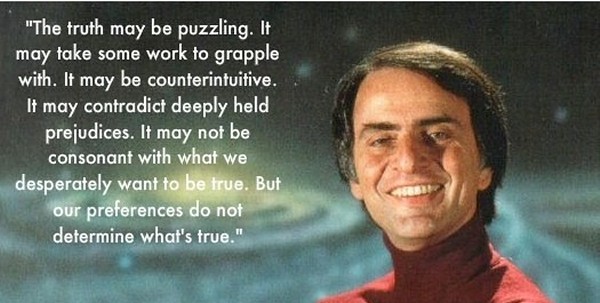 |
In the end, I
accept that I am completely dependent on the words and works
of others.
As I have made
perfectly clear, I have no medical training. Nor do I
have any direct experience to share that might cast light on
this argument. I don't know much more about the efficacy of
Burzynski's treatment than I do about the existence of God.
I have great
respect for
Dr. Research's
career as a
cancer researcher.
Throughout the Debate, I have
always kept in mind that he has deep knowledge of a field in
which I am largely ignorant. Consequently this has put
me at a major disadvantage and prevented me from rebutting
his message more forcibly.
To review how
this Debate began, Dr.
Research directly
contradicted a statement I made to him in an email:
Rick Archer wrote to Dr. Research:
Let Burzynski go about his business without the
constant harassment. If the man is wrong, then
let his failed results speak for themselves.
Like herbal tea and apricot seeds, his cure
isn't 'hurting' anyone, so leave him to do his
research in peace.
|
Dr. Research
replied,
Rick, you couldn't be more
wrong on some points (and borderline insulting).
Yes, insulting, especially considering our respective
backgrounds in the field.
Once you've made up your mind
with the conspiracy angle, presenting the other side
with reasonable explanations runs into a brick wall.
But at the risk of being insulting,
Rick, you don't know what
you don't know. And, there is more at stake here
than switching milk brands.
I have underlined the
most disturbing paragraph you've written.
Given that bold
statement, I told
Dr. Research
that I expected him to share what his reasons were for
warning me about Burzynski.
It took him a
while, but he finally came through with his answers... which
I have in turn shared with you without edit.
As I have said
before, my only goal is
to get it right. If
Burzynski is a fake, I would be crushed
to know I was mistaken. As
Dr.
Research
correctly pointed out, it would be wrong to set
desperate people up like that.
I will now conclude
with these final points.
-
First, yes, I think there is a Conspiracy. But I don't
think the Conspiracy has anything to do with
Dr. Research
or the fine doctors over at MD Anderson who deeply care
about their patients. These are men and women who
are in Medicine for the right reason - to heal their
patients and find a cure for cancer.
-
Second, as one has surely gathered, the majority of the
Mainstream Medical Community does not trust Burzynski's
work. They think he is either a fraud or he is
misguided. There is a possibility that they are
wrong. They have been wrong before. The
work of Barry
Marshall on the true cause of ulcers stands as a
recent and very telling example.
-
Third, it appears that the "Conspiracy" has gone to a
great deal of Morris Fishbein-style trouble (Chapter
Five) to suppress information about Burzynski's
work. By limiting Burzynski's access to
publication, this would explain why people don't trust
him. Because Burzynski "doesn't publish", he
doesn't exist. Therefore the casual doctor
concludes he must be hiding something.
In a sense, the two Eric Merola Documentaries have
served as a brilliant counter-attack to get his message
out despite the media suppression. Merola's first
Documentary reached Dr. Oz. Then it reached
me as well and made me curious enough to purchase the
Second Documentary. Fascinated by the message
contained in both movies, I have decided to pass the message on to the
Reader.
Hopefully, slowly but surely, the word about Burzynski will get around.
-
Fourth, I have laid out a great deal of information
based on the two documentaries that is supportive of
Burzynski's work. However, keep in mind that I
have no way to vouch for the validity of any of this
information. All I can say is that I have shared
my sources and I have not deliberately twisted any
facts. Furthermore, I have no knowledge of
any dark deep
secrets about Burzynski to hide. If I thought
something I read was important, I shared it. So let the
Universe set my karma accordingly.
-
Fifth, I would like to remind everyone that I have
absolutely no financial stake in my reports. I write for
one reason only... evil flourishes when good men say
nothing. I hope that bolsters my personal credibility in
the reader's eyes.
-
Finally, I would like to thank
Dr. Research
for sharing this information. I am positive much
of what he says is
not readily available elsewhere. I consider us all
fortunate that Dr.
Research has gone to so
much trouble to pass on what he thinks to be true.
There can be
little doubt that Dr.
Research does not trust
Burzynski and has little respect for him. That said, I
do not agree with Dr.
Research. I very much
believe that Dr. Burzynski is on a path that will lead to a
cure for cancer unless he is stopped.
BUT I CAN'T
PROVE THIS. I
therefore leave it up to
the reader to make up their own mind.
Here is a
cautionary note written by a friend of mine who reviewed
this chapter in advance of publication.
This person not
only has extensive medical training, he is a cancer survivor
cured by conventional techniques. Furthermore, my
personal relationship with him tells me he has both an open
mind and a basic decency about him. These factors
added together make this man a highly reliable source.
"You
may or may not be aware that there are a vast host
of snake oil peddlers out there with supposed cures
for cancer. I became aware of many of them when my
holistic sister-in-law was researching alternative
treatments for my father-in-law who had been
diagnosed with end stage lung cancer. Ionized water
which cannot be shipped without losing its power.
Massive massive doses of vitamin C. You name it.
Most of
them are very expensive – sometimes cripplingly so.
Some of them are even harmful. Most of them are
preying on desperate people looking for some ray of
hope. I have to wonder if Dr. Research has those
abuses in the back of his mind when commenting about
Burzynski. It would be hard not to. One could get
the impression that Burzynski is marketing his
product for personal gain."
I wish to remind
the Reader one last time that
Dr. Research
is far more knowledgeable about the medical aspects of
cancer than I can ever hope to be. If
Dr. Research
says Burzynski is suspicious, then with reluctance I will
continue to keep my guard up and gather more information.
I advise the Reader to do the same.
I openly admit
the day may come when I realize
Dr. Research
was right along. I very much hope that day never
comes, but as Carl Sagan made clear, just because I want it
to be true doesn't make it so.
In the meantime,
welcome to the confusing world of Medicine. On the
subject of Burzynski, there is no certainty, but much hope.
"Modern medicine is a
“Civil War” waged between conventional physicians and those who are open to
alternative cures for
maladies ranging from anxiety to cancer..."
- Mehmet Oz
“Medicine is a very religious experience. I have my religion and you have yours.
It becomes difficult for us to agree on what we think works, since
so much of it is in the eye of the beholder. Data is rarely
clean. You find the arguments that support your
data and then it’s my fact versus your fact.”
- Mehmet Oz
|
|
FOOTNOTE
Here is some
information I ran across just after I finished my chapter.
The reader will surely recall that Eric Merola is the man
who made both Burzynski documentaries. Merola has an
extensive
Frequently Asked Questions page regarding
Burzynski's work.
Listed here
is an interesting question plus Merola's response.
It lists one study after another that report benefits
resulting from Burzinsky's treatment. Furthermore, keep in mind that these results are posted at the
National
Cancer Institute web page, the same institution that once
attempted to copycat Burzynski's patents. This fact
alone lends considerable credibility to these findings.
Question to
Eric Merola FAQ Page:
9. Does the National
Cancer Institute acknowledge the clinical efficacy of
Antineoplastons today?
Yes,
CLICK HERE
and view
"Table 2" (or just look below)... last
update April, 2013.
Also
CLICK HERE
to see a longer National Cancer
Institute posting including some results from brainstem
glioma Phase 2 trials of Antineoplastons.
|
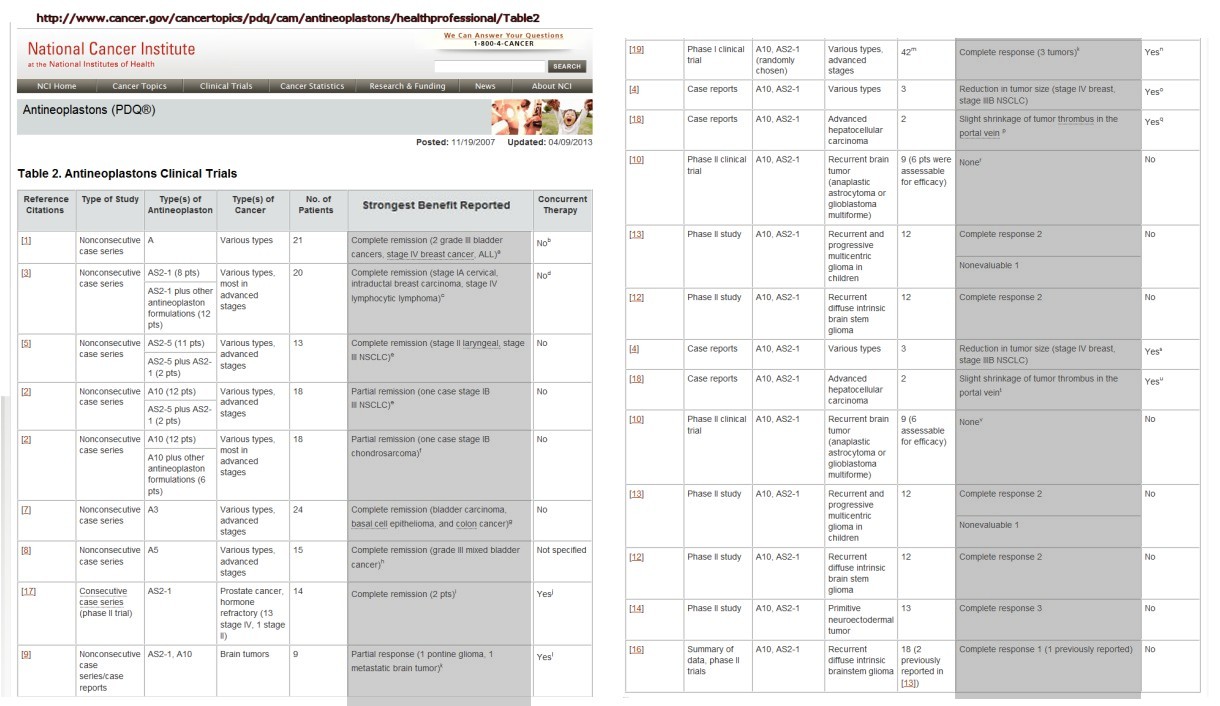 |
True progress in medicine has always, without
exception, been violently resisted by medical
authorities who cling to the beliefs of their times
-
Dr. Julian Whitaker
|
|